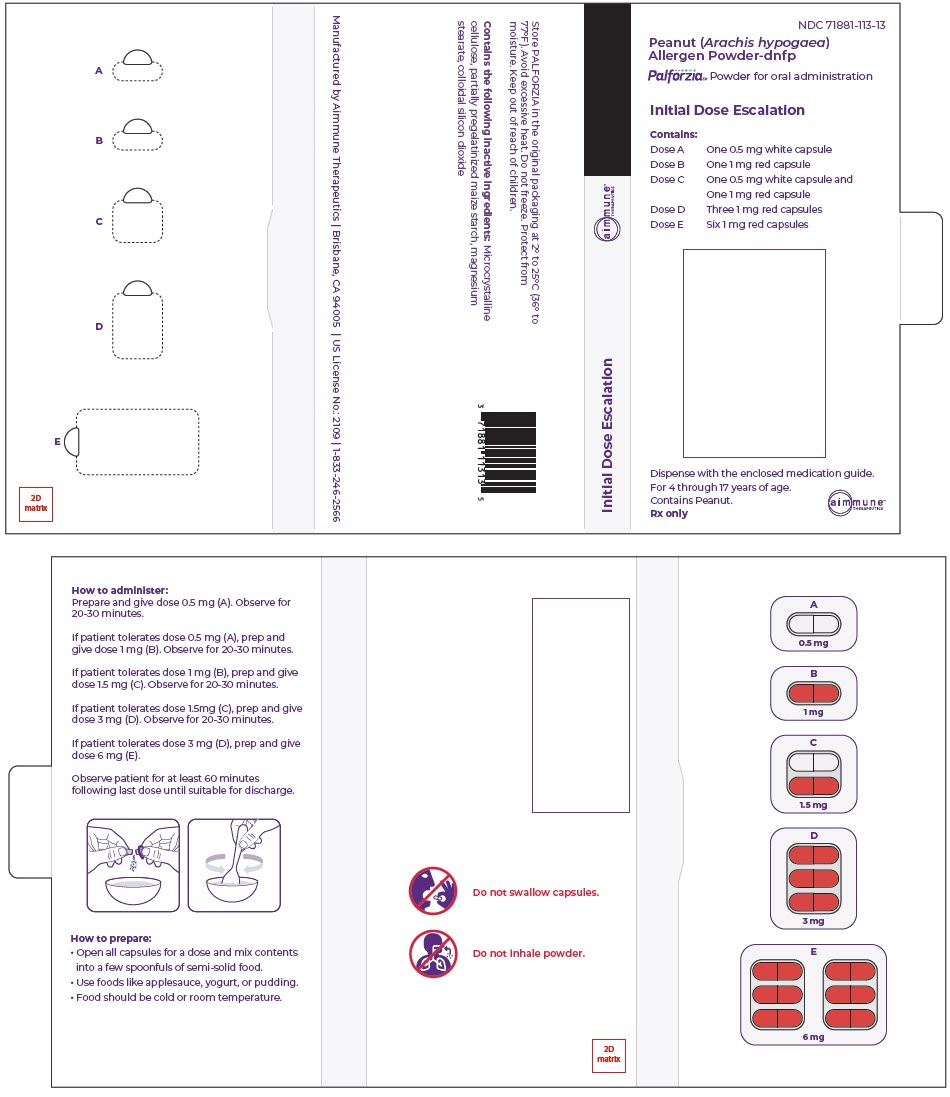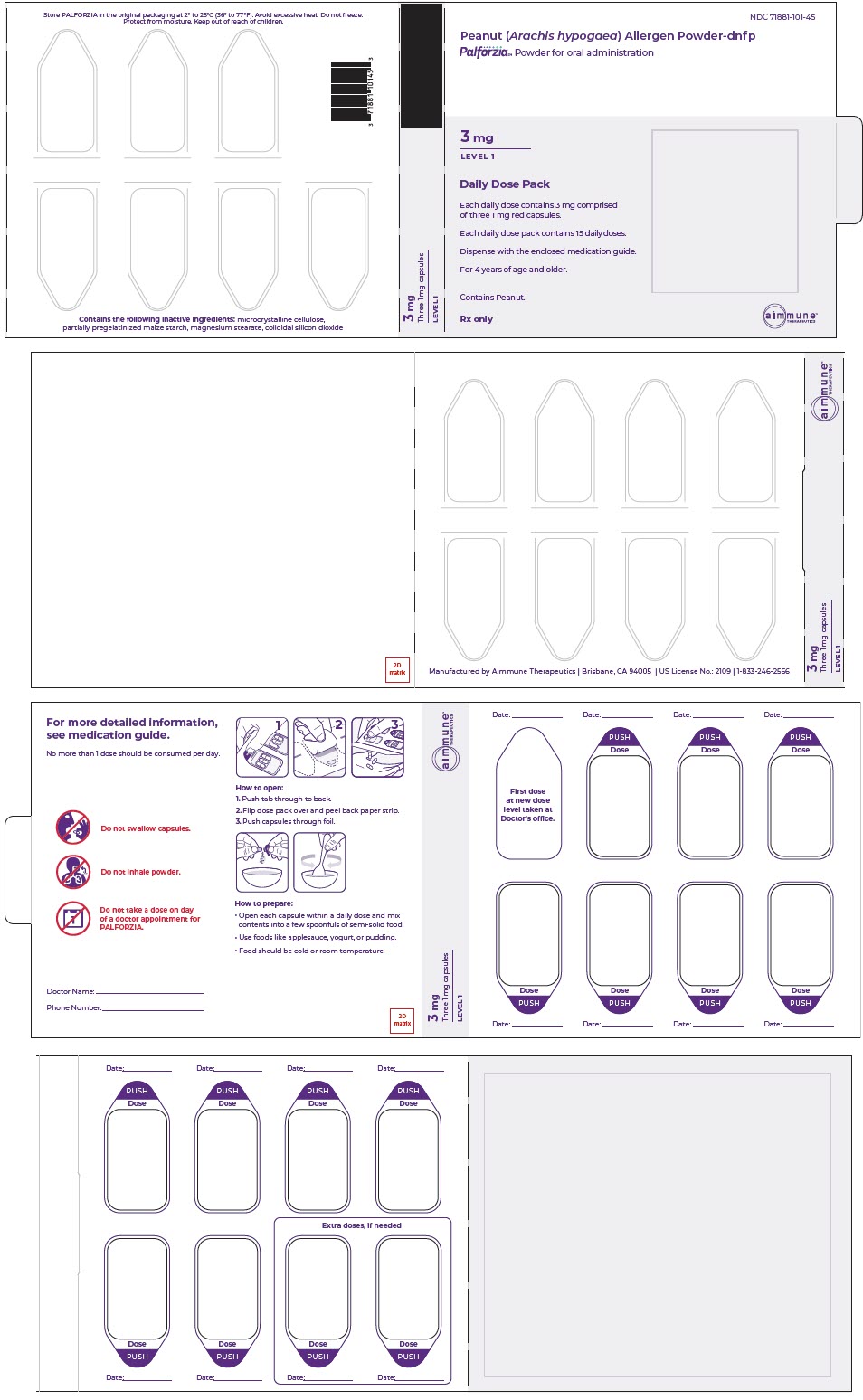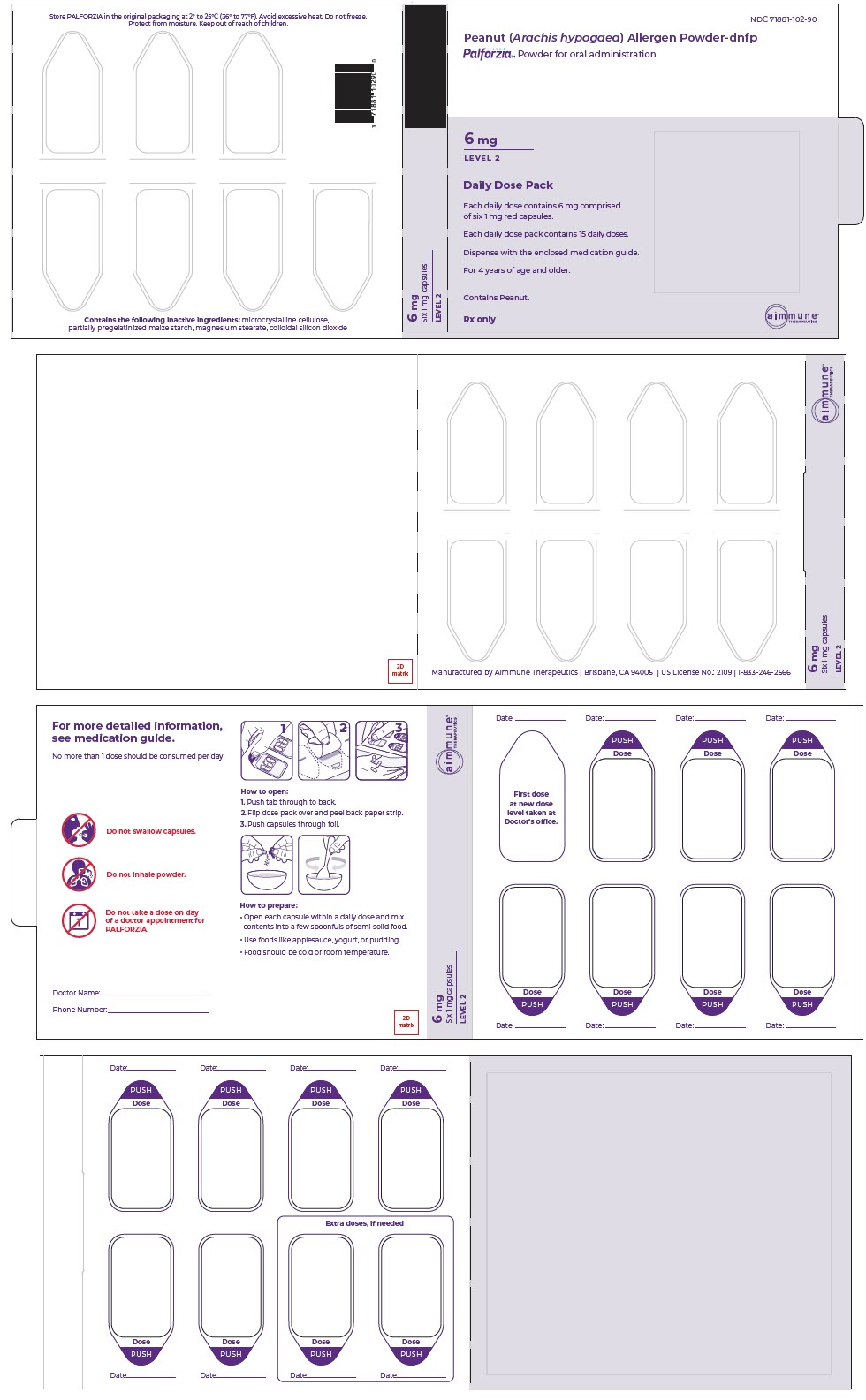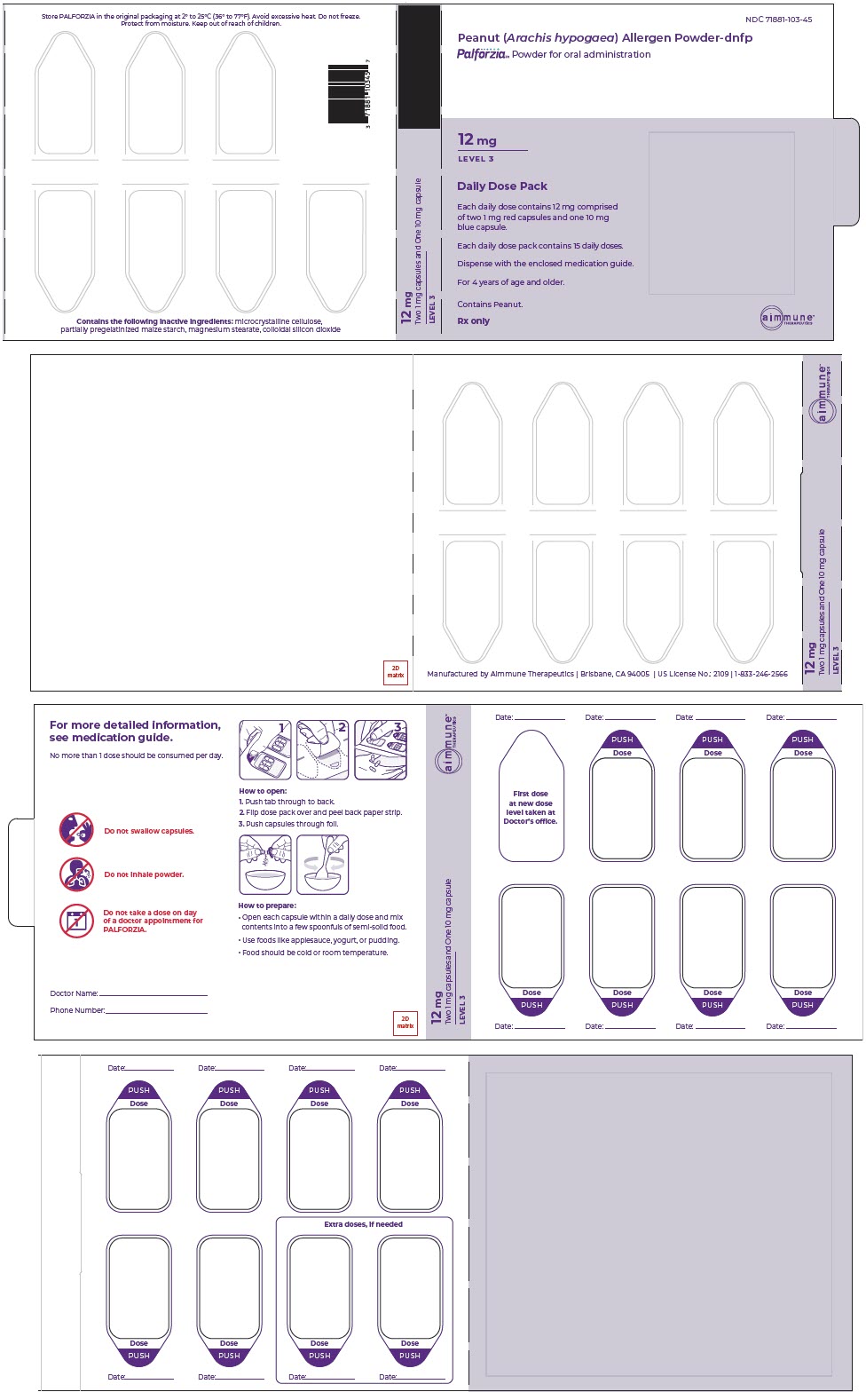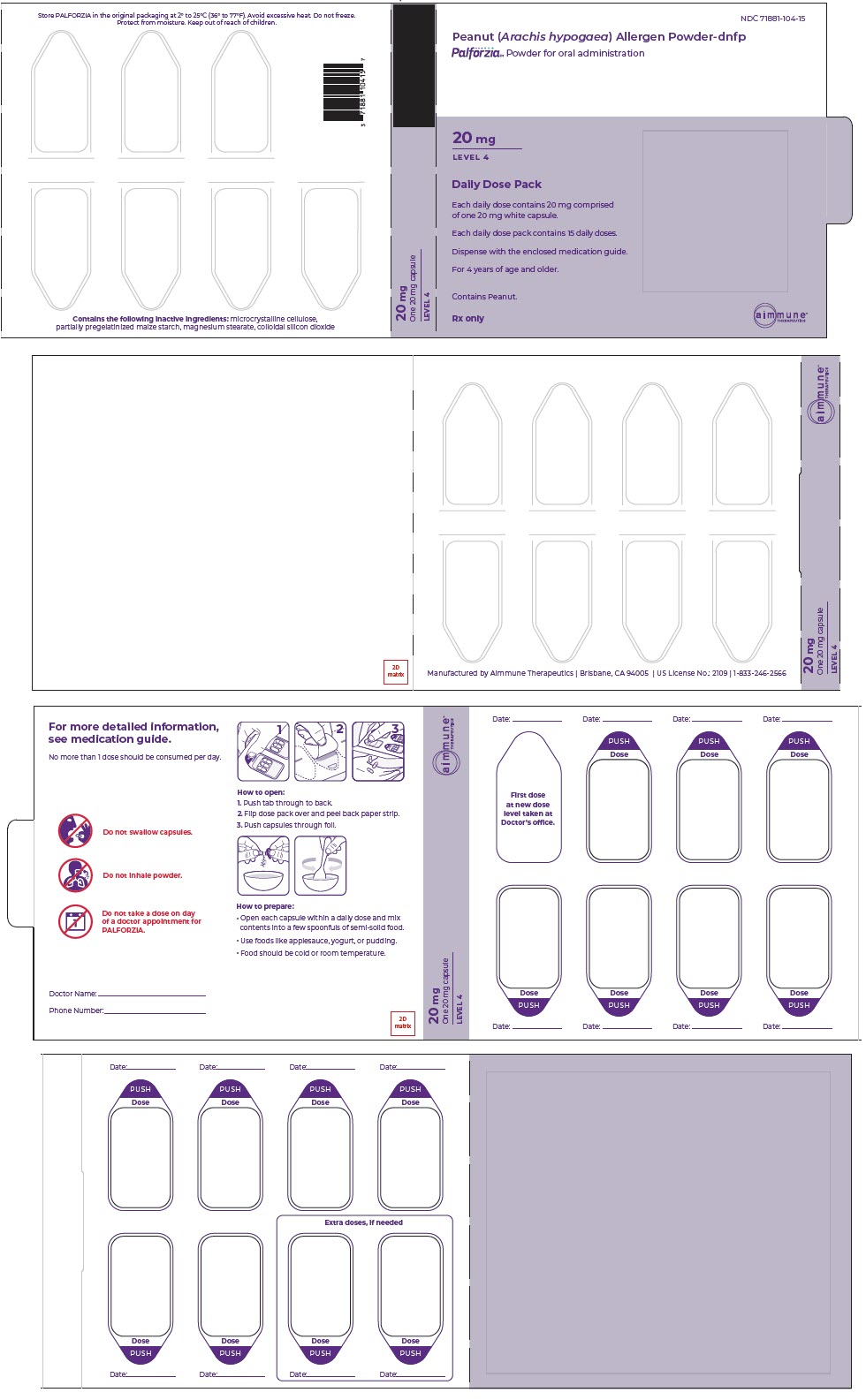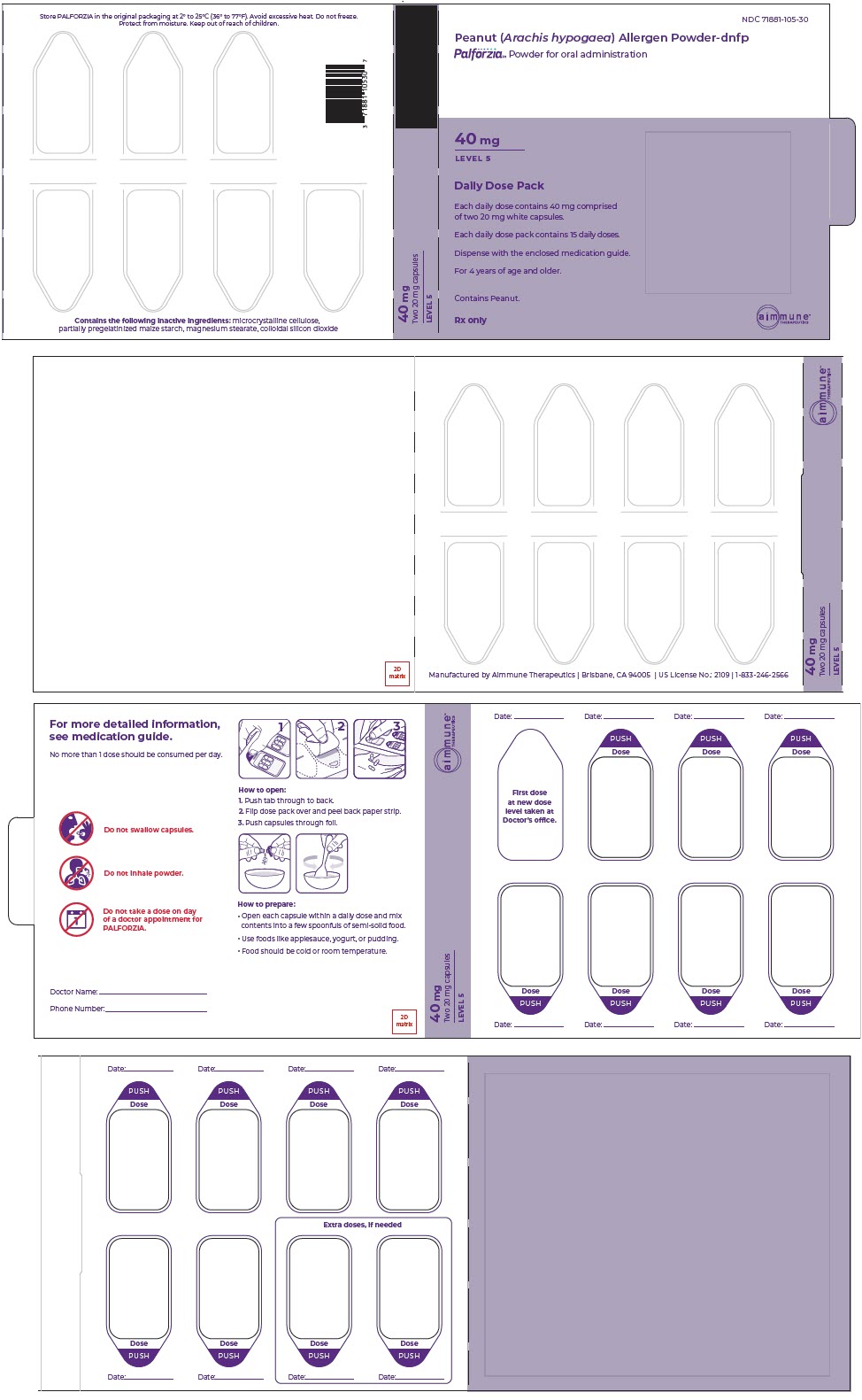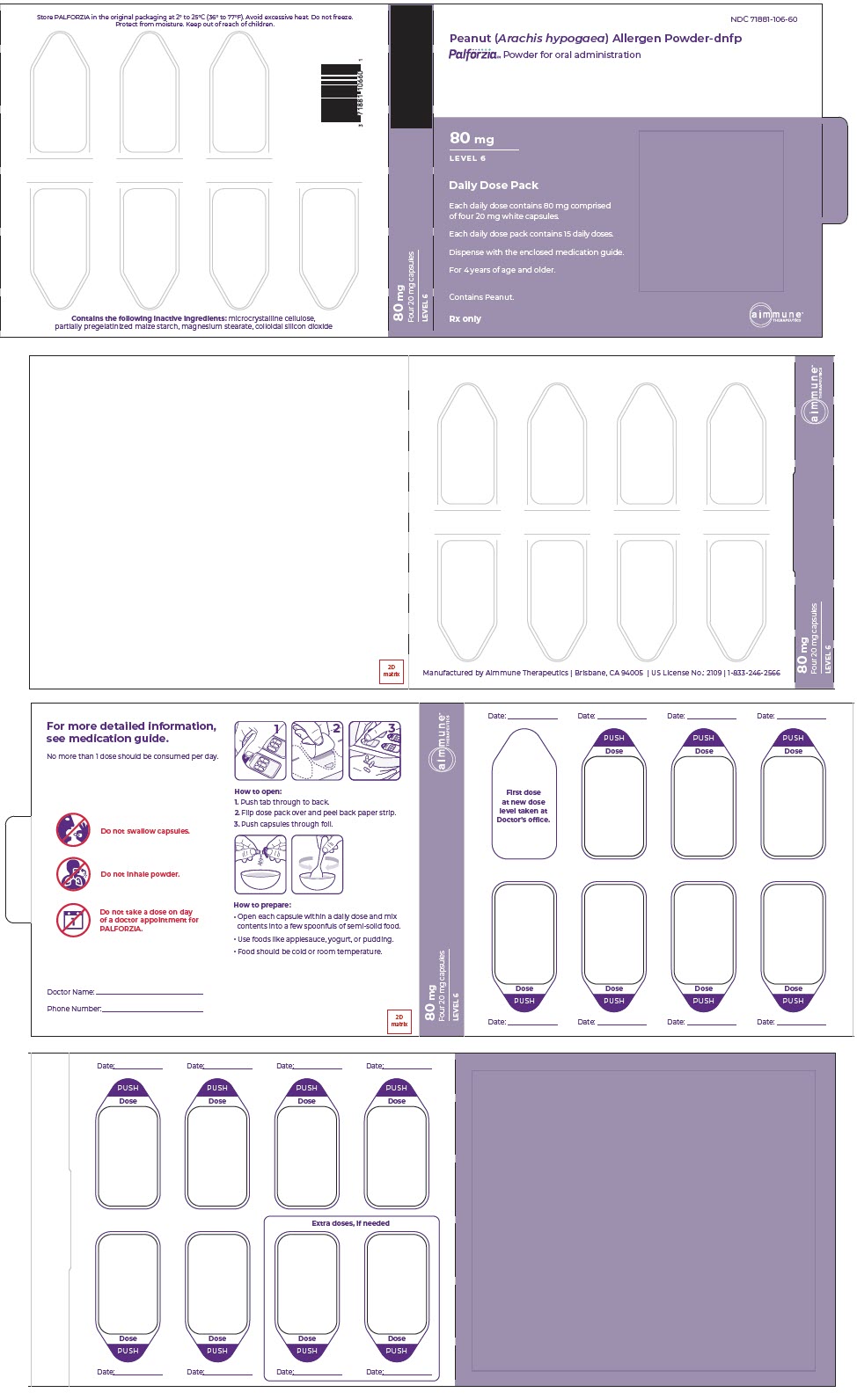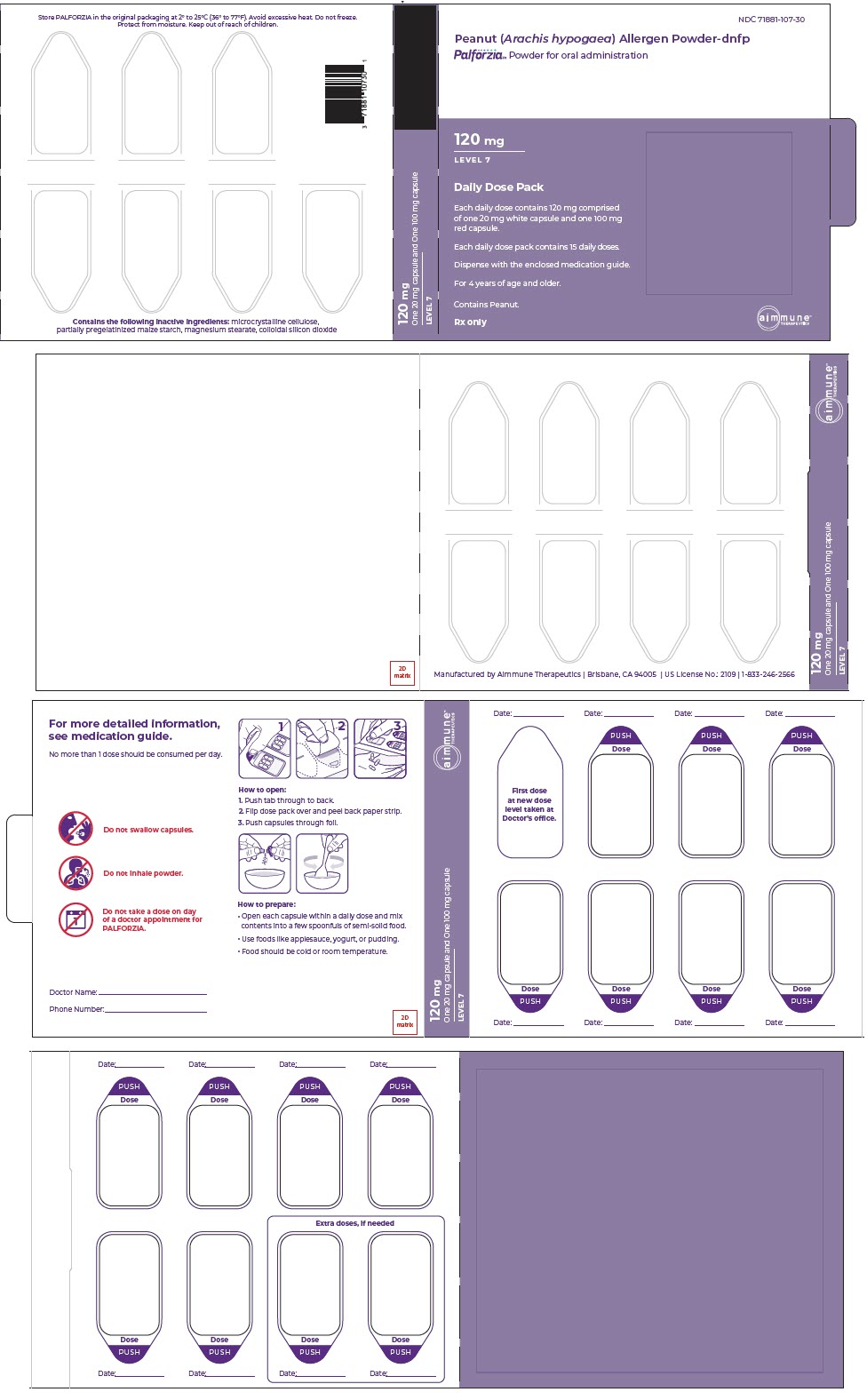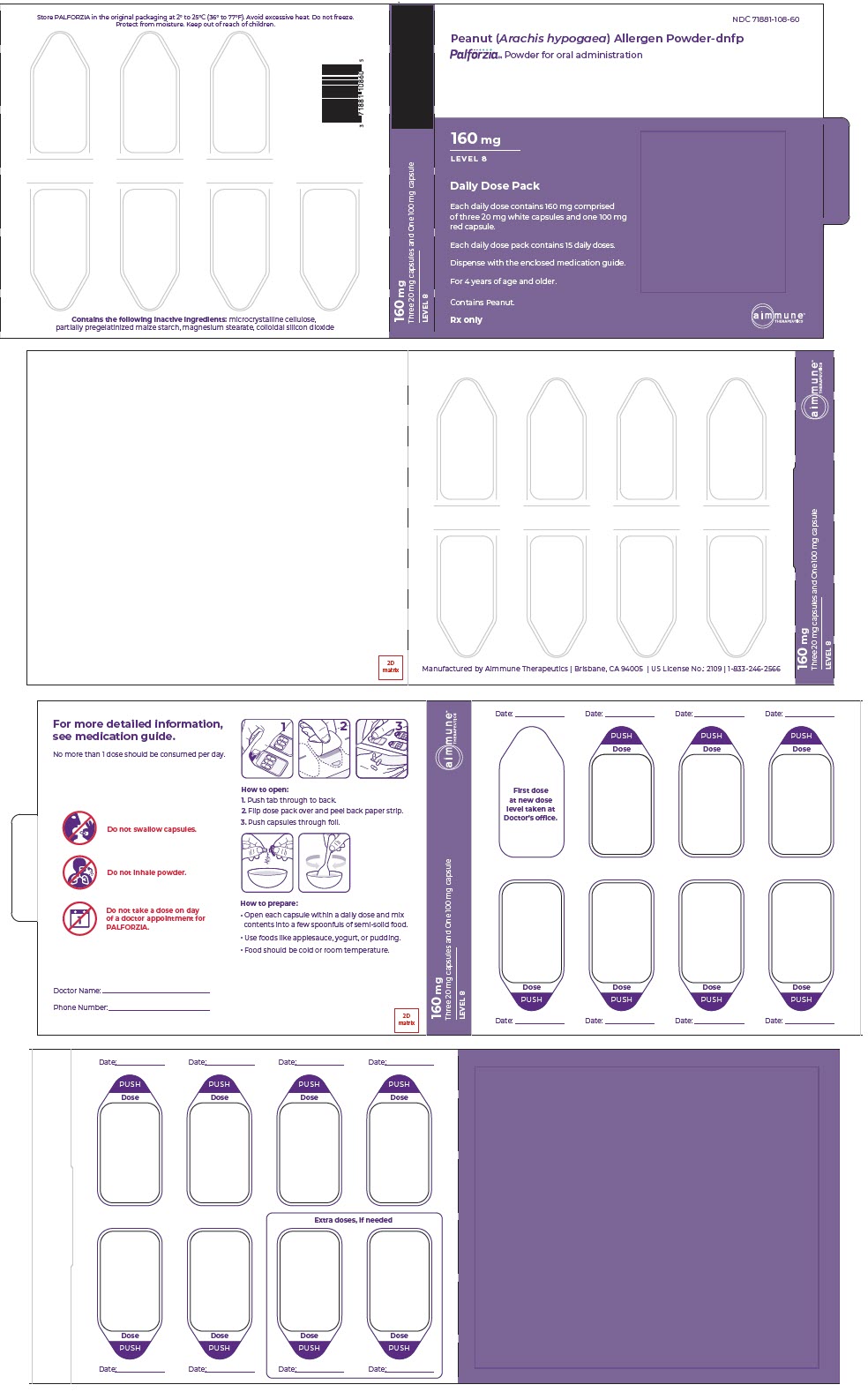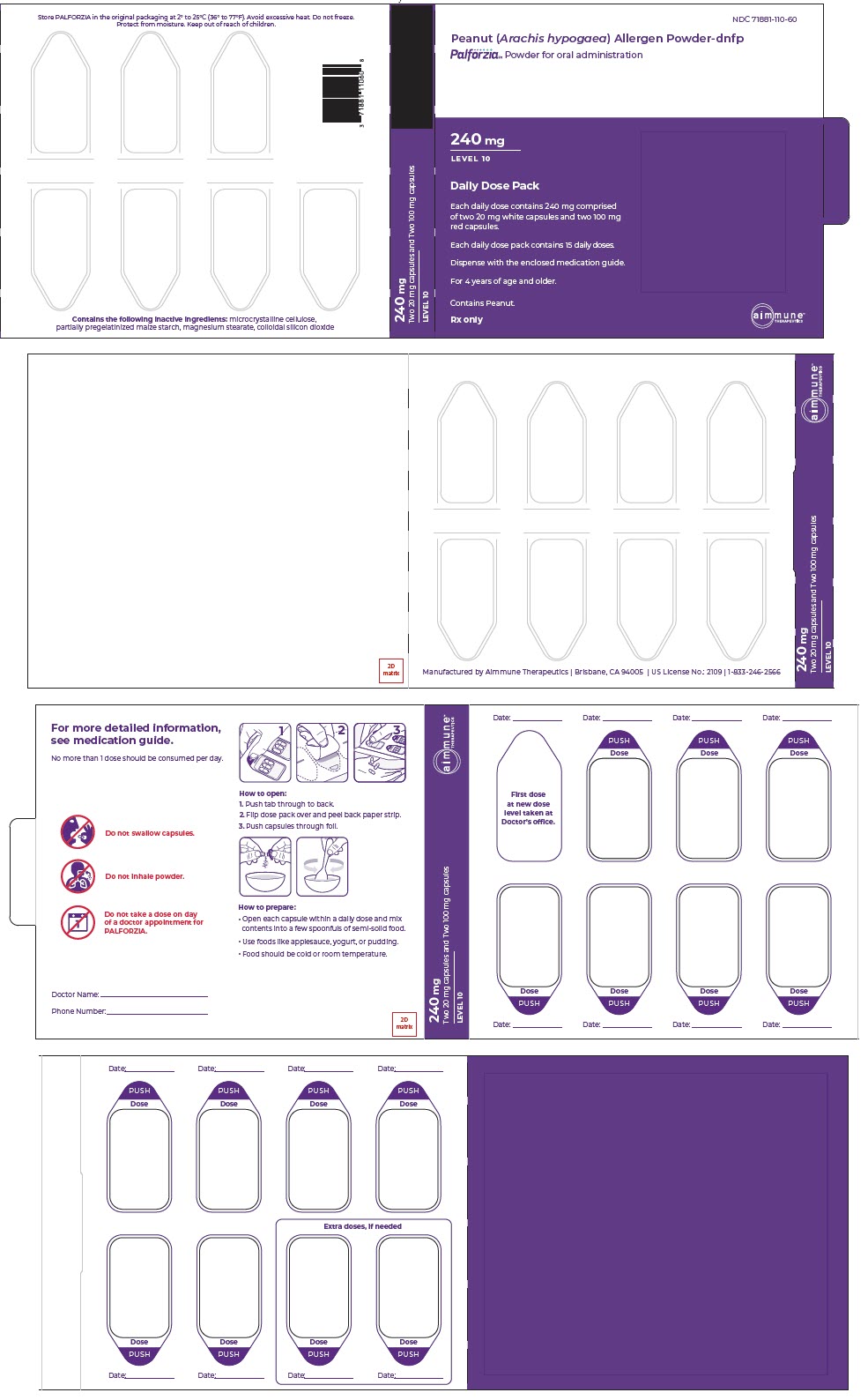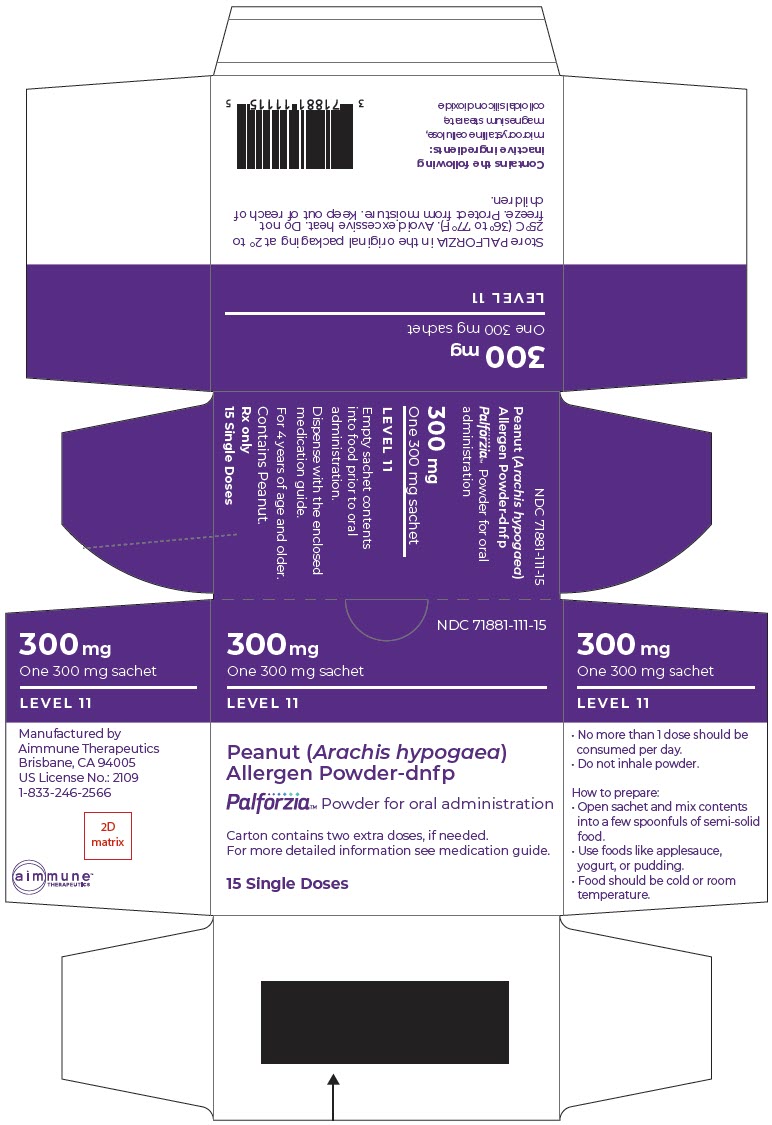Label: PALFORZIA INITIAL DOSE ESCALATION- peanut kit
PALFORZIA (LEVEL 1)- peanut powder
PALFORZIA (LEVEL 2)- peanut powder
PALFORZIA (LEVEL 3)- peanut kit
PALFORZIA (LEVEL 4)- peanut powder
PALFORZIA (LEVEL 5)- peanut powder
PALFORZIA (LEVEL 6)- peanut powder
PALFORZIA (LEVEL 7)- peanut kit
PALFORZIA (LEVEL 8)- peanut kit
PALFORZIA (LEVEL 9)- peanut powder
PALFORZIA (LEVEL 10)- peanut kit
PALFORZIA (LEVEL 11)- peanut powder
-
NDC Code(s):
71881-101-09,
71881-101-45,
71881-101-99,
71881-102-09, view more71881-102-90, 71881-102-99, 71881-103-09, 71881-103-45, 71881-103-99, 71881-104-09, 71881-104-15, 71881-104-99, 71881-105-09, 71881-105-30, 71881-105-99, 71881-106-09, 71881-106-60, 71881-106-99, 71881-107-09, 71881-107-30, 71881-107-99, 71881-108-09, 71881-108-60, 71881-108-99, 71881-109-09, 71881-109-30, 71881-109-99, 71881-110-09, 71881-110-60, 71881-110-99, 71881-111-15, 71881-111-30, 71881-111-99, 71881-113-13, 71881-121-01, 71881-122-01, 71881-123-01, 71881-124-01, 71881-125-01
- Packager: Aimmune Therapeutics
- Category: HUMAN PRESCRIPTION DRUG LABEL
- DEA Schedule: None
- Marketing Status: Biologic Licensing Application
Drug Label Information
Updated March 17, 2023
If you are a consumer or patient please visit this version.
- Download DRUG LABEL INFO: PDF XML
- Medication Guide: HTML
- Official Label (Printer Friendly)
-
HIGHLIGHTS OF PRESCRIBING INFORMATION
These highlights do not include all the information needed to use PALFORZIA safely and effectively. See Full Prescribing Information for PALFORZIA.
PALFORZIA [Peanut ( Arachis hypogaea) Allergen Powder-dnfp] Powder for oral administration
Initial U.S. Approval: 2020WARNING: ANAPHYLAXIS
See Full Prescribing Information for complete boxed warning.
- PALFORZIA can cause anaphylaxis, which may be life-threatening and can occur at any time during PALFORZIA therapy ( 5.1).
- Prescribe injectable epinephrine, instruct and train patients on its appropriate use, and instruct patients to seek immediate medical care upon its use ( 5.1).
- Do not administer PALFORZIA to patients with uncontrolled asthma ( 4).
- Dose modifications may be necessary following an anaphylactic reaction ( 2.5).
- Observe patients during and after administration of the Initial Dose Escalation and the first dose of each Up-Dosing level, for at least 60 minutes ( 2.4).
- PALFORZIA is available only through a restricted program called the PALFORZIA REMS ( 5.2).
INDICATIONS AND USAGE
PALFORZIA is an oral immunotherapy indicated for the mitigation of allergic reactions, including anaphylaxis, that may occur with accidental exposure to peanut. PALFORZIA is approved for use in patients with a confirmed diagnosis of peanut allergy. Initial Dose Escalation may be administered to patients aged 4 through 17 years. Up-Dosing and Maintenance may be continued in patients 4 years of age and older ( 2.4).
PALFORZIA is to be used in conjunction with a peanut-avoidant diet.
Limitation of Use: Not indicated for the emergency treatment of allergic reactions, including anaphylaxis.
DOSAGE AND ADMINISTRATION
For oral administration only ( 2)
- Do not swallow capsule(s).
- Do not inhale powder.
- Open capsule(s) or sachet and empty the entire dose of PALFORZIA powder onto refrigerated or room temperature semisolid food.
- Mix well.
- Consume the entire volume.
Initial Dose Escalation Total Dose Dose Configuration 0.5 mg One 0.5 mg capsule 1 mg One 1 mg capsule 1.5 mg One 0.5 mg capsule; One 1 mg capsule 3 mg Three 1 mg capsules 6 mg Six 1 mg capsules Up-Dosing Total Daily Dose Daily Dose Configuration 3 mg Three 1 mg capsules 6 mg Six 1 mg capsules 12 mg Two 1 mg capsules; One 10 mg capsule 20 mg One 20 mg capsule 40 mg Two 20 mg capsules 80 mg Four 20 mg capsules 120 mg One 20 mg capsule; One 100 mg capsule 160 mg Three 20 mg capsules; One 100 mg capsule 200 mg Two 100 mg capsules 240 mg Two 20 mg capsules; Two 100 mg capsules 300 mg One 300 mg sachet Maintenance Total Daily Dose Daily Dose Configuration 300 mg One 300 mg sachet DOSAGE FORMS AND STRENGTHS
Powder for oral administration supplied in 0.5 mg 1 mg, 10 mg, 20 mg and 100 mg Capsules or 300 mg Sachets. (3)
CONTRAINDICATIONS
WARNINGS AND PRECAUTIONS
- Anaphylaxis: PALFORZIA can cause anaphylaxis. Educate patients to recognize the signs and symptoms of anaphylaxis. Prescribe injectable epinephrine, instruct and train patients on its appropriate use, and instruct patients to seek immediate medical care upon its use ( 5.1).
- Asthma: Ensure patients with asthma have their asthma under control prior to initiation of PALFORZIA. PALFORZIA should be temporarily withheld if the patient is experiencing an acute asthma exacerbation. PALFORZIA has not been studied in patients with severe asthma ( 5.3).
- Eosinophilic esophagitis: PALFORZIA is associated with eosinophilic esophagitis. Monitor patients for signs and symptoms and discontinue PALFORZIA if eosinophilic esophagitis is suspected ( 5.4).
- Gastrointestinal reactions: If patients develop chronic or recurrent local gastrointestinal allergic symptoms, consider dose modification or discontinuation of treatment ( 5.5).
ADVERSE REACTIONS
The most common adverse reactions reported in subjects treated with PALFORZIA (incidence ≥ 5% and at least 5 percentage points greater than that reported in subjects treated with placebo) are abdominal pain, vomiting, nausea, oral pruritus, oral paresthesia, throat irritation, cough, rhinorrhea, sneezing, throat tightness, wheezing, dyspnea, pruritus, urticaria, anaphylactic reaction, and ear pruritus ( 6.1).
To report SUSPECTED ADVERSE REACTIONS, contact Aimmune Therapeutics at toll-free phone 1-833-246-2566 or FDA at 1-800-FDA-1088 or www.fda.gov/medwatch.
See 17 for PATIENT COUNSELING INFORMATION and Medication Guide.
Revised: 3/2023
-
Table of Contents
FULL PRESCRIBING INFORMATION: CONTENTS*
WARNING: ANAPHYLAXIS
1 INDICATIONS AND USAGE
2 DOSAGE AND ADMINISTRATION
2.1 Important Considerations Prior to Initiation and During Therapy
2.2 Dosage
2.3 Preparation and Handling
2.4 Administration
2.5 Schedule Modification and Product Discontinuation
3 DOSAGE FORMS AND STRENGTHS
4 CONTRAINDICATIONS
5 WARNINGS AND PRECAUTIONS
5.1 Anaphylaxis
5.2 PALFORZIA REMS Program
5.3 Asthma
5.4 Eosinophilic Gastrointestinal Disease
5.5 Gastrointestinal Adverse Reactions
6 ADVERSE REACTIONS
6.1 Clinical Trial Experience
8 USE IN SPECIFIC POPULATIONS
8.1 Pregnancy
8.2 Lactation
8.4 Pediatric Use
10 OVERDOSAGE
11 DESCRIPTION
12 CLINICAL PHARMACOLOGY
12.1 Mechanism of Action
13 NONCLINICAL TOXICOLOGY
13.1 Carcinogenesis, Mutagenesis, Impairment of Fertility
14 CLINICAL STUDIES
16 HOW SUPPLIED/STORAGE AND HANDLING
17 PATIENT COUNSELING INFORMATION
- *
- Sections or subsections omitted from the full prescribing information are not listed.
-
BOXED WARNING
(What is this?)
WARNING: ANAPHYLAXIS
- PALFORZIA can cause anaphylaxis, which may be life-threatening and can occur at any time during PALFORZIA therapy [see Warnings and Precautions (5.1)] .
- Prescribe injectable epinephrine, instruct and train patients on its appropriate use, and instruct patients to seek immediate medical care upon its use [see Warnings and Precautions (5.1)] .
- Do not administer PALFORZIA to patients with uncontrolled asthma [see Contraindications (4)] .
- Dose modifications may be necessary following an anaphylactic reaction [see Dosage and Administration (2.5)] .
- Observe patients during and after administration of the Initial Dose Escalation and the first dose of each Up-Dosing level, for at least 60 minutes [see Dosage and Administration (2.4)] .
- Because of the risk of anaphylaxis, PALFORZIA is available only through a restricted program under a Risk Evaluation and Mitigation Strategy (REMS) called the PALFORZIA REMS [see Warnings and Precautions (5.2)] .
-
1 INDICATIONS AND USAGE
PALFORZIA is an oral immunotherapy indicated for the mitigation of allergic reactions, including anaphylaxis, that may occur with accidental exposure to peanut. PALFORZIA is approved for use in patients with a confirmed diagnosis of peanut allergy. Initial Dose Escalation may be administered to patients aged 4 through 17 years. Up-Dosing and Maintenance may be continued in patients 4 years of age and older [see Dosage and Administration (2.4)] .
PALFORZIA is to be used in conjunction with a peanut-avoidant diet.
-
2 DOSAGE AND ADMINISTRATION
2.1 Important Considerations Prior to Initiation and During Therapy
Verify that the patient has injectable epinephrine and instruct patient on its appropriate use [see Warnings and Precautions (5.2)] .
2.2 Dosage
Treatment with PALFORZIA is administered in 3 sequential phases: Initial Dose Escalation, Up-Dosing, and Maintenance.
The dose configurations for each phase of dosing are provided in Table 1 through Table 3.
Table 1: Dosing Configuration for Initial Dose Escalation (Single Day Dose Escalation) Dose Level Total Dose Dose Configuration Initial Dose Escalation supplied as a single card consisting of 5 blisters containing a total of 13 capsules. A 0.5 mg One 0.5 mg capsule B 1 mg One 1 mg capsule C 1.5 mg One 0.5 mg capsule; One 1 mg capsule D 3 mg Three 1 mg capsules E 6 mg Six 1 mg capsules Table 2: Daily Dosing Configuration for Up-Dosing Dose Level Total Daily Dose Daily Dose Configuration Dose Duration (weeks) 1 3 mg Three 1 mg capsules 2 2 6 mg Six 1 mg capsules 2 3 12 mg Two 1 mg capsules; One 10 mg capsule 2 4 20 mg One 20 mg capsule 2 5 40 mg Two 20 mg capsules 2 6 80 mg Four 20 mg capsules 2 7 120 mg One 20 mg capsule; One 100 mg capsule 2 8 160 mg Three 20 mg capsules; One 100 mg capsule 2 9 200 mg Two 100 mg capsules 2 10 240 mg Two 20 mg capsules; Two 100 mg capsules 2 11 300 mg One 300 mg sachet 2 Table 3: Daily Dosing Configuration for Maintenance Dose Level Total Daily Dose Daily Dose Configuration 11 300 mg One 300 mg sachet 2.3 Preparation and Handling
PALFORZIA is to be administered orally.
- Open capsule(s) or sachet and empty the entire dose of PALFORZIA powder onto a few spoonfuls of refrigerated or room temperature semisolid food (e.g., applesauce, yogurt, pudding). Do not use liquid (e.g., milk, water, juice) to prepare.
- Mix well.
- Consume the entire volume of the prepared mixture promptly.
- Dispose of the opened capsule(s) or sachet.
- Wash hands immediately after handling PALFORZIA capsule(s) or sachets.
- Dispose of all unused PALFORZIA.
2.4 Administration
- For oral administration only.
- Do not swallow capsule(s).
- Do not inhale powder.
Initial Dose Escalation
Initial Dose Escalation is administered on a single day under the supervision of a health care professional in a health care setting with the ability to manage potentially severe allergic reactions, including anaphylaxis.
Initial Dose Escalation is administered in sequential order on a single day beginning at Level A (5 Levels A-E, 0.5-6 mg; Table 1).
Each dose should be separated by an observation period of 20 to 30 minutes.
No dose level should be omitted.
Observe patients after the last dose for at least 60 minutes until suitable for discharge.
Discontinue PALFORZIA if symptoms requiring medical intervention (e.g., use of epinephrine) occur with any dose during Initial Dose Escalation [see Dosage and Administration (2.5)] .
Patients who tolerate at least the 3 mg single dose (Level D) of PALFORZIA during Initial Dose Escalation must return to the health care setting for initiation of Up-Dosing.
If possible, begin Up-Dosing the day after Initial Dose Escalation.
Repeat Initial Dose Escalation in a health care setting if the patient is unable to begin Up-Dosing within 4 days.
Up-Dosing
Complete Initial Dose Escalation before starting Up-Dosing.
Up-Dosing consists of 11 dose levels and is initiated at a 3 mg dose (Level 1).
The first dose of each new Up-Dosing level is administered under the supervision of a health care professional in a health care setting with the ability to manage potentially severe allergic reactions, including anaphylaxis.
Observe patients after administering the first dose of a new Up-Dosing level for at least 60 minutes until suitable for discharge.
If the patient tolerates the first dose of the increased dose level, the patient may continue that dose level at home. Each dose should be consumed daily with a meal at approximately the same time each day, preferably in the evening.
Administer all the dose levels in Table 2 in sequential order at 2-week intervals if tolerated.
No dose level should be omitted.
Do not progress through Up-Dosing more rapidly than shown in Table 2.
No more than 1 dose should be consumed per day. Instruct patients not to consume a dose at home on the same day as a dose consumed in the clinic.
Consider dose modification or discontinuation for patients who do not tolerate Up-Dosing as described in Table 2 [see Dosage and Administration (2.5)] .
2.5 Schedule Modification and Product Discontinuation
Dose Modification
Dose modifications are not appropriate during Initial Dose Escalation.
Temporary dose modification of PALFORZIA may be required for patients who experience allergic reactions during Up-Dosing or Maintenance, for patients who miss doses, or for practical reasons of patient management. Allergic reactions, including gastrointestinal reactions, that are severe, recurrent, bothersome, or last longer than 90 minutes during Up-Dosing or Maintenance should be actively managed with dose modifications. Use clinical judgment to determine the best course of action, which can include maintaining the dose level for longer than 2 weeks, reducing, withholding, or discontinuing PALFORZIA doses.
Management of Consecutive Missed Doses
Following 1 to 2 consecutive days of missed doses, patients may resume PALFORZIA at the same dose level. Data are insufficient to inform resumption of PALFORZIA following 3 or more consecutive days of missed doses. Patients who miss 3 or more consecutive days of PALFORZIA should consult their healthcare providers; resumption of PALFORZIA should be done under medical supervision.
Discontinuation of PALFORZIA
Discontinue treatment with PALFORZIA for:
- Patients who are unable to tolerate doses up to and including the 3 mg dose during Initial Dose Escalation
- Patients with suspected eosinophilic esophagitis [see Warnings and Precautions (5.4 and 5.5)]
- Patients unable to comply with the daily dosing requirements
- Patients with recurrent asthma exacerbations or persistent loss of asthma control
-
3 DOSAGE FORMS AND STRENGTHS
PALFORZIA powder description and dosage strengths are as follows:
- 0.5 mg: white to off-white fine granular oral powder (may contain clumps) in white opaque capsules with Aimmune printed on the body and 0.5 mg printed on the cap in grey ink
- 1 mg: white to off-white fine granular oral powder (may contain clumps) in red opaque capsules with Aimmune printed on the body and 1 mg printed on the cap in white ink
- 10 mg: white to off-white fine granular oral powder (may contain clumps) in blue opaque capsules with Aimmune printed on the body and 10 mg printed on the cap in white ink
- 20 mg: off-white to light beige fine granular oral powder (may contain clumps) in white opaque capsules with Aimmune printed on the body and 20 mg printed on the cap in grey ink
- 100 mg: beige fine oral powder (may contain clumps) in red opaque capsules with Aimmune printed on the body and 100 mg printed on the cap in white ink
- 300 mg: beige fine oral powder (may contain clumps) in white foil-laminate sachets with printed information
Combinations of capsules for doses are described in Dosage and Administration (2.2).
-
4 CONTRAINDICATIONS
PALFORZIA is contraindicated in patients with the following:
- Uncontrolled asthma [see Warnings and Precautions (5.3)]
- A history of eosinophilic esophagitis and other eosinophilic gastrointestinal disease [see Warnings and Precautions (5.4 and 5.5)]
-
5 WARNINGS AND PRECAUTIONS
5.1 Anaphylaxis
PALFORZIA can cause anaphylaxis, which may be life-threatening.
Anaphylaxis has been reported during all phases of PALFORZIA dosing, including Maintenance and in subjects who have undergone recommended Up-Dosing and dose modification procedures.
In 709 PALFORZIA-treated subjects and 292 placebo-treated subjects in the placebo-controlled population in Studies 1 and 2 combined [see Adverse Reactions (6.1)] , anaphylaxis was reported in 9.4% of PALFORZIA-treated subjects compared with 3.8% of placebo-treated subjects during Initial Dose Escalation and Up-Dosing combined, and in 8.7% of PALFORZIA-treated subjects compared with 1.7% of placebo-treated subjects during Maintenance in Study 1. Epinephrine use for any reason was reported in 10.4% of PALFORZIA-treated subjects compared with 4.8% of placebo-treated subjects during Initial Dose Escalation and Up-Dosing combined, and in 7.7% of PALFORZIA-treated subjects compared with 3.4% of placebo-treated subjects during Maintenance dosing in Study 1. Time to onset of anaphylaxis occurred within 2 hours after dosing in 70% of reactions, greater than 2 hours and up to 10 hours in 18% of reactions, and greater than 10 hours in 12% of reactions among PALFORZIA-treated subjects.
Do not initiate PALFORZIA treatment in a patient who has had severe or life-threatening anaphylaxis within the previous 60 days. PALFORZIA may not be suitable for patients with certain medical conditions that may reduce the ability to survive anaphylaxis, including but not limited to markedly compromised lung function, severe mast cell disorder, or cardiovascular disease. In addition, PALFORZIA may not be suitable for patients taking medications that can inhibit or potentiate the effects of epinephrine.
All Initial Dose Escalation doses and the first dose of each Up-Dosing level must be administered under observation in a health care setting [see Dosage and Administration (2.5)] . Prior to initiating PALFORZIA treatment, educate patients to recognize the signs and symptoms of anaphylaxis. Prescribe injectable epinephrine, instruct and train patients on its appropriate use, and instruct patients to seek immediate medical care upon its use. Instruct patients to contact their health care professional before administering the next dose of PALFORZIA if anaphylaxis or symptoms of an escalating or persistent allergic reaction occur as dose modification may be necessary [see Dosage and Administration (2.4)] .
Patients may be more likely to experience allergic reactions following PALFORZIA administration in the presence of cofactors such as exercise, hot water exposure, intercurrent illness (e.g., viral infection), or fasting. Other potential cofactors may include menstruation, sleep deprivation, nonsteroidal anti-inflammatory drug use, or uncontrolled asthma. Patients should be proactively counseled about the potential for the increased risk of anaphylaxis in the presence of these cofactors. If possible, adjust the time of dosing to avoid these cofactors. If it is not possible to avoid these cofactors, consider withholding PALFORZIA temporarily.
If appropriate to re-start administering PALFORZIA in patients who experienced anaphylaxis while on PALFORZIA or who had doses withheld to avoid increased risk of anaphylaxis, consider a dose reduction and dose re-escalation based on clinical judgment [see Dosage and Administration (2.5)] .
PALFORZIA is available only through a restricted program under a REMS [see Warnings and Precautions (5.2)] .
5.2 PALFORZIA REMS Program
PALFORZIA is available only through a restricted program under a Risk Evaluation and Mitigation Strategy (REMS) called the PALFORZIA REMS because of the risk of anaphylaxis [see Warnings and Precautions (5.1)] .
Notable requirements of the PALFORZIA REMS include the following:
- Health care providers who prescribe PALFORZIA must be certified with the program by enrolling.
- Health care settings must be certified in the program, have on-site access to equipment and personnel trained to manage anaphylaxis, and establish policies and procedures to verify that patients are monitored during and after the Initial Dose Escalation and first dose of each Up-Dosing level.
- Patients must be enrolled in the program prior to initiation of PALFORZIA treatment and must be informed of the need to have injectable epinephrine available for immediate use at all times, the need for monitoring with the Initial Dose Escalation and first dose of each Up-Dosing level, the need for continued dietary peanut avoidance, and how to recognize the signs and symptoms of anaphylaxis.
- Pharmacies must be certified with the program and must only dispense PALFORZIA to health care settings that are certified or to patients who are enrolled depending on the treatment phase.
Further information, including a list of certified prescribers, health care settings, and pharmacies, is available at www.PALFORZIAREMS.com or 1-844-PALFORZ (1-844-725-3679).
5.3 Asthma
Uncontrolled asthma is a risk factor for a serious outcome, including death, in anaphylaxis. Ensure patients with asthma have their asthma under control prior to initiation of PALFORZIA.
PALFORZIA should be temporarily withheld if the patient is experiencing an acute asthma exacerbation. Following resolution of the exacerbation, resumption of PALFORZIA should be undertaken cautiously [see Dosage and Administration (2.5)] . Re-evaluate patients who have recurrent asthma exacerbations and consider discontinuation of PALFORZIA. PALFORZIA has not been studied in subjects with severe asthma, persistently uncontrolled asthma, or patients on long-term systemic corticosteroid therapy.
5.4 Eosinophilic Gastrointestinal Disease
In clinical studies, 28 of 1050 (2.7%) subjects were referred for a gastroenterology evaluation and 17 of these 28 subjects reported undergoing an esophagogastroduodenoscopy (EGD). Of subjects who underwent an EGD, 12 were diagnosed with biopsy-confirmed eosinophilic esophagitis while receiving PALFORZIA compared with 0 of 292 (0%) subjects receiving placebo. After discontinuation of PALFORZIA, symptomatic improvement was reported in 12 of 12 subjects. In 8 subjects with available follow-up biopsy results, eosinophilic esophagitis was resolved in 6 subjects and improved in 2 subjects [see Contraindications (4)] .
Discontinue PALFORZIA and consider a diagnosis of eosinophilic esophagitis in patients who experience severe or persistent gastrointestinal symptoms, including dysphagia, vomiting, nausea, gastroesophageal reflux, chest pain, or abdominal pain [see Warnings and Precautions (5.5)] .
5.5 Gastrointestinal Adverse Reactions
Gastrointestinal adverse reactions, including abdominal pain, vomiting, nausea, oral pruritus, and oral paresthesia, were commonly reported in PALFORZIA-treated subjects in the placebo-controlled clinical study population [see Adverse Reactions (6, Table 4)] . Dose modification should be considered for patients who report these reactions [see Dosage and Administration (2.5)]. For severe or persistent gastrointestinal symptoms consider a diagnosis of eosinophilic esophagitis [see Warnings and Precautions (5.4)] .
-
6 ADVERSE REACTIONS
6.1 Clinical Trial Experience
Use of PALFORZIA has been associated with:
- Anaphylaxis [see Warnings and Precautions (5.1)]
- Eosinophilic esophagitis [see Warnings and Precautions (5.4)]
Because clinical trials are conducted under widely varying conditions, adverse reaction rates observed in clinical trials of a drug cannot be directly compared with the adverse reaction rates in clinical trials of another drug and may not reflect the rates observed in practice.
The clinical data for PALFORZIA reflect exposure in 709 peanut-allergic subjects enrolled in two phase 3, double-blind, placebo-controlled trials (Study 1 and Study 2), and in long-term, open-label, follow-on studies. In Study 1, subjects were Up-Dosed for 20-40 weeks followed by Maintenance dosing for 24-28 weeks. In Study 2 subjects were Up-Dosed for 20-40 weeks up to a 300 mg daily dose with no extended Maintenance dosing. In these studies, subjects recorded adverse reactions daily in an electronic diary card throughout the study duration.
Study 1 (NCT02635776) was a randomized, double-blind, placebo-controlled efficacy and safety study conducted in the United States, Canada, and Europe evaluating PALFORZIA versus placebo in 555 subjects aged 4 through 55 years with peanut allergy. Subjects were required to have serum IgE to peanut ≥ 0.35 kUA/L within 12 months before study entry and/or a mean wheal diameter on skin prick test to peanut ≥ 3 mm greater than the negative control. The primary analysis population was aged 4 through 17 years, 78% white and 57% male. At study entry, subjects reacted at 100 mg or less of peanut protein in a double-blind, placebo-controlled food challenge (DBPCFC). The primary analysis was conducted in 496 subjects aged 4 through 17 years (PALFORZIA, N = 372; placebo, N = 124). Of the subjects aged 4 through 17 years treated with PALFORZIA, 72% had a medical history of anaphylactic reactions to peanut, 66% reported multiple food allergies, 63% had a medical history of atopic dermatitis, and 53% had a present or previous diagnosis of asthma. Subjects with severe persistent or uncontrolled asthma were excluded.
Study 2 (NCT03126227) was a randomized, double-blind, placebo-controlled safety study conducted in the United States and Canada evaluating PALFORZIA versus placebo in 506 subjects aged 4 through 17 years with peanut allergy. Subjects were required to have a clinical history of peanut allergy including onset of characteristic allergic signs and symptoms within 2 hours of known oral exposure to peanut, serum IgE to peanut of ≥ 14 kUA/L and a mean wheal diameter on skin prick test ≥ 8 mm greater than the negative control at screening. Subjects were not required to complete a DBPCFC for study entry. The study duration was approximately 6 months and compared the safety and tolerability of PALFORZIA (N = 337) with placebo (N = 168). Most subjects were male (63%) and white (79%). Of the subjects treated with PALFORZIA, 60.5% had a medical history of anaphylactic reactions, 65.0% reported multiple food allergies, 57.9% had a medical history of atopic dermatitis, and 52.2% had a present or previous diagnosis of asthma. Subjects with severe persistent or uncontrolled asthma were excluded.
Across these two phase 3, double-blind, placebo-controlled, randomized clinical studies the most common adverse reactions in subjects treated with PALFORZIA (incidence ≥ 5% and at least 5 percentage points greater than in subjects treated with placebo) were gastrointestinal, respiratory, and skin symptoms commonly associated with allergic reactions, as shown in Table 4.
Table 4: Treatment-Emergent Adverse Reactions in ≥ 5% of PALFORZIA-Treated Subjects and ≥ 5% Percentage Points Greater Than Placebo-Treated Subjects in any Dosing Phase (Aged 4 through 17 Years) System Organ Class /
Preferred Term *Study 1 & Study 2
IDE
PALFORZIA
(N = 709)Study 1 & Study 2
IDE
Placebo
(N = 292)Study 1 & Study 2
Up-Dosing
PALFORZIA
(N = 693)Study 1 & Study 2
Up-Dosing
Placebo
(N = 289)Study 1 †
300 mg
PALFORZIA
(N = 310)Study 1 †
300 mg
Placebo
(N = 118)At each level of summarization (any event, system organ class, or preferred term) subjects with more than 1 adverse reaction were counted only once within each study period. IDE, Initial Dose Escalation; MedDRA, Medical Dictionary for Regulatory Activities. - *
- Adverse events were coded to system organ class and preferred term using the MedDRA, version 19.1.
- †
- In Study 2, no adverse reactions ≥ 5% were reported in subjects following treatment with 300 mg PALFORZIA (N = 265).
- ‡
- Includes preferred terms of abdominal pain, abdominal pain upper, and abdominal discomfort.
- §
- Includes preferred terms of oral pruritus, tongue pruritis, and lip pruritus.
- ¶
- The anaphylactic reaction preferred term includes systemic allergic reactions of any severity, of which severe anaphylaxis was reported in 4 PALFORZIA-treated subjects (0.6%) during Up-Dosing and 1 PALFORZIA-treated subject (0.3%) during Maintenance.
Gastrointestinal disorders Abdominal pain ‡ 185 (26.1%) 24 (8.2%) 465 (67.1%) 100 (34.6%) 90 (29.0%) 20 (16.9%) Vomiting 22 (3.1%) 2 (0.7%) 253 (36.5%) 47 (16.3%) 50 (16.1%) 14 (11.9%) Nausea 60 (8.5%) 2 (0.7%) 224 (32.3%) 41 (14.2%) 45 (14.5%) 8 (6.8%) Oral pruritus § 62 (8.7%) 9 (3.1%) 216 (31.2%) 30 (10.4%) 51 (16.5%) 7 (5.9%) Oral paresthesia 13 (1.8%) 7 (2.4%) 94 (13.6%) 11 (3.8%) 23 (7.4%) 2 (1.7%) Respiratory, thoracic, and mediastinal disorders Throat irritation 66 (9.3%) 15 (5.1%) 279 (40.3%) 49 (17.0%) 43 (13.9%) 11 (9.3%) Cough 18 (2.5%) 1 (0.3%) 221 (31.9%) 68 (23.5%) 61 (19.7%) 22 (18.6%) Rhinorrhea 9 (1.3%) 4 (1.4%) 145 (20.9%) 50 (17.3%) 46 (14.8%) 9 (7.6%) Sneezing 24 (3.4%) 8 (2.7%) 140 (20.2%) 31 (10.7%) 33 (10.6%) 5 (4.2%) Throat tightness 18 (2.5%) 3 (1.0%) 98 (14.1%) 8 (2.8%) 20 (6.5%) 0 (0.0%) Wheezing 4 (0.6%) 0 (0.0%) 85 (12.3%) 21 (7.3%) 19 (6.1%) 10 (8.5%) Dyspnea 2 (0.3%) 1 (0.3%) 53 (7.6%) 5 (1.7%) 17 (5.5%) 1 (0.8%) Skin and subcutaneous tissue disorders Pruritus 56 (7.9%) 16 (5.5%) 225 (32.5%) 59 (20.4%) 45 (14.5%) 14 (11.9%) Urticaria 28 (3.9%) 10 (3.4%) 197 (28.4%) 54 (18.7%) 63 (20.3%) 17 (14.4%) Immune system disorders Anaphylactic reaction ¶ 5 (0.7%) 1 (0.3%) 63 (9.1%) 10 (3.5%) 27 (8.7%) 2 (1.7%) Ear and labyrinth disorders Ear pruritus 5 (0.7%) 1 (0.3%) 41 (5.9%) 2 (0.7%) 7 (2.3%) 0 (0.0%) A total of 155 (21.9%) PALFORZIA-treated subjects and 19 (6.5%) placebo-treated subjects discontinued for any reason in Studies 1 and 2. Adverse reactions led to study discontinuation in 9.2% PALFORZIA-treated subjects and 1.7% placebo-treated subjects during Initial Dose Escalation and Up-Dosing combined in Studies 1 and 2, and 1.0% PALFORZIA-treated subjects and no placebo-treated subjects during Maintenance dosing in Study 1. Gastrointestinal reactions were the most common reason leading to discontinuation of study product during Initial Dose Escalation and Up-Dosing combined (6.5% PALFORZIA, 1.0% placebo), followed by respiratory disorders (2.3% PALFORZIA, 1.0% placebo) in Studies 1 and 2.
The timing of symptoms relative to exposure to PALFORZIA was evaluated for dosing that occurred within a clinical setting during Initial Dose Escalation and on the day of initiation of each new dose level during the Up-Dosing phase (every 2 weeks) and during monthly Maintenance visits. Symptoms occurring in the clinic following any dose of PALFORZIA had a median time to onset of 4 minutes for 502 subjects (70.8%). The median time to resolution of the last symptom was 37 minutes.
-
8 USE IN SPECIFIC POPULATIONS
8.1 Pregnancy
Pregnancy Registry
There is a pregnancy exposure registry that monitors pregnancy outcomes in women exposed to PALFORZIA during pregnancy. Women exposed to PALFORZIA during pregnancy or their health care professionals are encouraged to contact Aimmune by calling 1-833-246-2566.
Risk Summary
All pregnancies have a risk of birth defect, loss, or other adverse outcomes. In the U.S. general population, the estimated background risk of major birth defects and miscarriage in clinically recognized pregnancies is 2% to 4% and 15% to 20%, respectively. No human or animal data are available to establish the presence or absence of the risks due to PALFORZIA in pregnant women.
Clinical Considerations
Disease-associated maternal and/or embryo/fetal risk
Anaphylaxis may occur following accidental exposure to peanut in peanut-allergic pregnant women. Anaphylaxis can cause a dangerous decrease in blood pressure, which could result in compromised placental perfusion and significant risk to a fetus.
Maternal adverse reactions
PALFORZIA may cause anaphylaxis [see Warnings and Precautions (5.1) and Fetal/Neonatal adverse reactions] .
Fetal/Neonatal adverse reactions
PALFORZIA may cause anaphylaxis [see Warnings and Precautions (5.1)] . Anaphylaxis can cause a dangerous decrease in blood pressure, which could result in compromised placental perfusion and significant risk to a fetus.
8.2 Lactation
Risk Summary
There are no data available on the presence of PALFORZIA in human milk, the effects on the breastfed infant, or the effects on milk production. The developmental and health benefits of breastfeeding should be considered, along with the mother's clinical need for PALFORZIA and any other potential adverse effects on the breastfed child from PALFORZIA or from the underlying maternal condition.
-
10 OVERDOSAGE
Symptoms of overdose in patients with peanut allergy may include hypersensitivity reactions such as anaphylaxis or local gastrointestinal allergic reactions [see Warnings and Precautions (5.1 and 5.5)] . In case of severe symptoms such as difficulty in swallowing, difficulty in breathing, changes in voice, feeling of fullness in the throat, or anaphylaxis, patients should be instructed to use epinephrine and seek immediate medical assistance [see Warnings and Precautions (5.1) and Patient Counseling Information (17)] .
-
11 DESCRIPTION
PALFORZIA (Peanut ( Arachis hypogaea) Allergen Powder-dnfp) is a powder for oral administration. PALFORZIA is manufactured from defatted peanut flour. PALFORZIA is available in capsules containing 0.5 mg, 1 mg, 10 mg, 20 mg, and 100 mg peanut protein, and a sachet containing 300 mg peanut protein. Each dose meets specifications for quantities of Ara h 1, Ara h 2, and Ara h 6, measured by immunoassay alone or in combination with high performance liquid chromatography.
Depending on the dose level, PALFORZIA contains the following inactive ingredients: microcrystalline cellulose, partially pregelatinized maize starch (0.5 mg, 1 mg, 10 mg, 20 mg capsule presentations only), magnesium stearate, and colloidal silicon dioxide.
- 12 CLINICAL PHARMACOLOGY
- 13 NONCLINICAL TOXICOLOGY
-
14 CLINICAL STUDIES
The efficacy of PALFORZIA for the mitigation of allergic reactions, including anaphylaxis, in patients with peanut allergy was investigated in Study 1 (NCT02635776). Study 1 was a phase 3, randomized, double-blind, placebo-controlled study of the efficacy and safety of PALFORZIA in patients with peanut allergy aged 4 through 55 years in the United States, Canada, and Europe. The primary analysis population consisted of 496 subjects (PALFORZIA, N = 372; placebo, N = 124) aged 4 through 17 years in the intent-to-treat (ITT) population who received at least 1 dose of study treatment. After an Initial Dose Escalation ranging from 0.5 mg to 6 mg on Day 1 and confirmation of tolerability of the 3 mg dose on Day 2, subjects underwent Up-Dosing for 20-40 weeks starting at 3 mg until the 300 mg dose was reached. The Up-Dosing period varied for each subject depending on how the dose was tolerated. Subjects then underwent 24-28 weeks of Maintenance immunotherapy with 300 mg PALFORZIA until the end of the study. At the end of the Maintenance period, subjects completed an exit DBPCFC to approximate an accidental exposure to peanut and to assess their ability to tolerate increasing amounts of peanut protein with no more than mild allergic symptoms.
The primary efficacy endpoint was the percentage of subjects tolerating a single dose of 600 mg peanut protein in the exit DBPCFC with no more than mild allergic symptoms after 6 months of Maintenance treatment. The primary efficacy endpoint was considered met if the lower bound of the 95% confidence interval (CI) for the difference in response rates between the treatment and the placebo groups was greater than the prespecified margin of 15%. Key secondary endpoints included the comparisons of the response rates after single doses of 300 mg and 1000 mg peanut protein as well as a comparison of the maximum severity of symptoms at any challenge dose of peanut protein during the exit DBPCFC. The key secondary endpoints were to be evaluated for statistical significance (two-sided p < 0.05) only if the primary endpoint and all the preceding tests in the hierarchy were statistically significant in favor of PALFORZIA. Response rates at the exit DBPCFC for the ITT population are shown in Table 5. The maximum severity of symptoms at any challenge is shown in Table 6.
Table 5: Response Rates at the Exit DBPCFC in Study 1 (ITT Population, 4 through 17 Years) Peanut challenge dose, single dose 300 mg * 600 mg † 1000 mg * Subjects without an exit DBPCFC were counted as non-responders. CI, confidence interval, DBPCFC, double-blind, placebo-controlled food challenge; ITT, intent-to-treat. - *
- Secondary endpoint was considered met if the Farrington-Manning test for a non-zero treatment difference was significant at the two-sided 0.05 level.
- †
- The primary efficacy endpoint was considered met if the lower bound of the Farrington-Manning 95% CI was greater than the prespecified margin of 15 percentage points.
PALFORZIA (N = 372) 76.6% 67.2% 50.3% Placebo (N = 124) 8.1% 4.0% 2.4% Treatment difference (95% CI) 68.5% (58.6%, 78.5%) 63.2% (53.0%, 73.3%) 47.8% (38.0%, 57.7%) P-value < 0.0001 < 0.0001 < 0.0001 The completer population consisted of all subjects aged 4 through 17 years in the ITT population who stayed on treatment and had an evaluable exit DBPCFC (296 PALFORZIA, 116 placebo). In the completer population, the proportion of subjects who tolerated single highest doses of 300 mg, 600 mg, and 1000 mg with no more than mild symptoms at the exit DBPCFC were 96.3%, 84.5%, and 63.2%, respectively for PALFORZIA-treated subjects compared with 8.6%, 4.3%, and 2.6% for placebo-treated subjects.
Table 6: Maximum Severity of Symptoms at Any Challenge Dose During the Exit DBPCFC (ITT Population, 4 through 17 Years) Symptom Severity PALFORZIA
N = 372Placebo
N = 124Subjects without an exit DBPCFC were assigned the maximum severity during the screening DBPCFC, which equates to no change from screening. P-value < 0.0001; symptom severity was assigned with equally spaced scores (e.g. 0, 1, 2, and 3 for none, mild, moderate, and severe, respectively), and the difference of mean scores between the two treatment arms was tested using the Cochran-Mantel-Haenszel statistic stratified by geographic region (North America, Europe). DBPCFC, double-blind, placebo-controlled food challenge; ITT, intent-to-treat. - *
- Includes severe symptoms and life-threatening or fatal reactions. No subjects had symptoms considered life-threatening or fatal.
None 37.6% 2.4% Mild 32.0% 28.2% Moderate 25.3% 58.9% Severe * 5.1% 10.5% There are no data available on the efficacy of PALFORZIA in individuals who did not progress onto Maintenance therapy.
-
16 HOW SUPPLIED/STORAGE AND HANDLING
Table 7: PALFORZIA Commercial Packaging Presentations Packaging Presentation Kit Components (Capsules or Sachets) Number of Doses per Kit NDC Numbers (Kit Components) NDC Number (Kit) NDC, National Drug Code. Initial Dose Each pack contains 13 capsules: 5 71881-113-13 Escalation • 0.5 mg (Level A) One 0.5 mg capsule 71881-121-01 • 1 mg (Level B) One 1 mg capsule 71881-122-01 • 1.5 mg (Level C) One 0.5 mg capsule; 71881-121-01 One 1 mg capsule 71881-122-01 • 3 mg (Level D) Three 1 mg capsules 71881-122-01 • 6 mg (Level E) Six 1 mg capsules 71881-122-01 Up-Dosing 3 mg Forty-five 1 mg capsules 15 71881-122-01 71881-101-45 (Level 1) 6 mg Ninety 1 mg capsules 15 71881-122-01 71881-102-90 (Level 2) 12 mg Thirty 1 mg capsules; 15 71881-122-01 71881-103-45 (Level 3) Fifteen 10 mg capsules 71881-123-01 20 mg Fifteen 20 mg capsules 15 71881-124-01 71881-104-15 (Level 4) 40 mg Thirty 20 mg capsules 15 71881-124-01 71881-105-30 (Level 5) 80 mg Sixty 20 mg capsules 15 71881-124-01 71881-106-60 (Level 6) 120 mg Fifteen 20 mg capsules; 15 71881-124-01 71881-107-30 (Level 7) Fifteen 100 mg capsules 71881-125-01 160 mg Forty-five 20 mg capsules; 15 71881-124-01 71881-108-60 (Level 8) Fifteen 100 mg capsules 71881-125-01 200 mg Thirty 100 mg capsules 15 71881-125-01 71881-109-30 (Level 9) 240 mg Thirty 20 mg capsules; 15 71881-124-01 71881-110-60 (Level 10) Thirty 100 mg capsules 71881-125-01 300 mg Fifteen 300 mg sachets 15 71881-111-01 71881-111-15 (Level 11) Maintenance 300 mg Thirty 300 mg sachets 30 71881-111-01 71881-111-30 (Level 11) Table 8: PALFORZIA Office Dose Kit Packaging Presentations Packaging Presentation Kit Components (Blisters, Capsules, or Sachets) Number of Doses per Kit NDC Numbers (Kit Components) NDC Number (Kit) NDC, National Drug Code. 3 mg Eighteen blisters, each containing: 18 71881-101-09 71881-101-99 (Level 1) Three 1 mg capsules 71881-122-01 6 mg Eighteen blisters, each containing: 18 71881-102-09 71881-102-99 (Level 2) Six 1 mg capsules 71881-122-01 12 mg Twelve blisters, each containing: 12 71881-103-09 71881-103-99 (Level 3) Two 1 mg capsules 71881-122-01 One 10 mg capsule 71881-123-01 20 mg Twelve blisters, each containing: 12 71881-104-09 71881-104-99 (Level 4) One 20 mg capsule 71881-124-01 40 mg Twelve blisters, each containing: 12 71881-105-09 71881-105-99 (Level 5) Two 20 mg capsules 71881-124-01 80 mg Twelve blisters, each containing: 12 71881-106-09 71881-106-99 (Level 6) Four 20 mg capsules 71881-124-01 120 mg Twelve blisters, each containing: 12 71881-107-09 71881-107-99 (Level 7) One 20 mg capsule 71881-124-01 One 100 mg capsule 71881-125-01 160 mg Twelve blisters, each containing: 12 71881-108-09 71881-108-99 (Level 8) Three 20 mg capsules 71881-124-01 One 100 mg capsule 71881-125-01 200 mg Twelve blisters, each containing: 12 71881-109-09 71881-109-99 (Level 9) Two 100 mg capsules 71881-125-01 240 mg Twelve blisters, each containing: 12 71881-110-09 71881-110-99 (Level 10) Two 20 mg capsules 71881-124-01 Two 100 mg capsules 71881-125-01 300 mg Fifteen 300 mg sachets 15 71881-111-09 71881-111-99 (Level 11) -
17 PATIENT COUNSELING INFORMATION
Advise patient, parent, or guardian to read the FDA-approved patient labeling ( Medication Guide).
Advise patient, parent, or guardian that patient should follow a strict peanut-avoidant diet.
Advise patient, parent, or guardian that PALFORZIA will not mitigate allergic reactions to other foods to which they might be allergic.
Allergic Reactions
Advise patient, parent, or guardian that PALFORZIA may cause allergic reactions, including anaphylaxis that may be life-threatening. Educate patient, parent, or guardian to recognize the signs and symptoms of an allergic reaction [see Warnings and Precautions (5.1)] . The signs and symptoms of a severe allergic reaction may include syncope, dizziness, hypotension, tachycardia, dyspnea, wheezing, bronchospasm, chest discomfort, cough, abdominal pain, vomiting, diarrhea, rash, pruritus, flushing, and urticaria.
Ensure patient has injectable epinephrine and instruct patient, parent, or guardian on its proper use and that injectable epinephrine must be available for immediate use at all times. Instruct patient, parent, or guardian that if patient experiences a severe allergic reaction to seek immediate medical care, discontinue PALFORZIA, and resume treatment only when advised by their health care professional [see Warnings and Precautions (5.1)] .
Advise patient, parent, or guardian to read the patient information for epinephrine.
Inform patient, parent, or guardian that the first dose of each dose level of PALFORZIA must be administered in a health care setting under the supervision of a health care professional, and that after consuming PALFORZIA, patient will be monitored for signs and symptoms of an allergic reaction [see Warnings and Precautions (5.1)] .
Advise patient, parent, or guardian that if patient experiences an escalating or persistent allergic reaction or becomes intolerant to PALFORZIA at home to contact their health care professional immediately.
Administration of PALFORZIA to young patients should be under adult supervision [see Dosage and Administration (2)] .
PALFORZIA Risk Evaluation and Mitigation Strategy (REMS) Program
Advise patient that due to the risk of anaphylaxis, PALFORZIA is only available through a restricted program called the PALFORZIA REMS Program [see Warnings and Precautions (5.2)] .
Inform patient, parent, or guardian of the following requirements:
- Patient must be enrolled in the PALFORZIA REMS Program.
- Patient, parent or guardian must be educated on the need for monitoring with the Initial Dose Escalation and first dose of each Up-Dosing level and how to recognize the signs and symptoms of anaphylaxis.
- Patient must continue dietary peanut avoidance.
- Injectable epinephrine must be available to patient for immediate use at all times.
Asthma
Instruct patient, parent, or guardian that patients with asthma should stop taking PALFORZIA and contact their health care professional immediately if they have difficulty breathing or if their asthma becomes difficult to control [see Warnings and Precautions (5.3)] .
Eosinophilic Esophagitis
Because of the risk of eosinophilic esophagitis, instruct patient, parent or guardian that patients with severe or persistent symptoms of esophagitis or gastrointestinal intolerance should discontinue PALFORZIA and contact their health care professional [see Warnings and Precautions (5.4 and 5.5)] .
Handling Instructions
Advise patient, parent, or guardian of the following:
- To store PALFORZIA in a refrigerator.
- That patient must not swallow capsule(s) or inhale the powder.
- To open capsule(s) or sachet and empty the entire dose onto a few spoonfuls of refrigerated or room temperature semisolid food (e.g., applesauce, yogurt, pudding) and to mix well. Do not use liquid (e.g., milk, water, juice) to prepare PALFORZIA for consumption.
- That patient should consume the entire prepared mixture.
- To dispose of all unused PALFORZIA [see Dosage and Administration (2.3)].
- To dispose of the opened capsule(s) or sachet and wash hands immediately after handling.
Dosing Instructions
Advise patient, parent, or guardian of the following:
- The importance of taking each dose daily to avoid loss of treatment effect.
- That each dose should be consumed with a meal, at approximately the same time each day, preferably in the evening.
- To observe the patient for at least 60 minutes after administering PALFORZIA for any signs of intolerability.
- To contact their health care professional for advice on how to resume PALFORZIA if doses are missed.
- That the risk of an allergic reaction following PALFORZIA administration may be increased in the presence of cofactors such as:
- Exercise or hot water exposure (e.g. a hypermetabolic state)
- A medical event such as an intercurrent illness (e.g., viral infection)
- Fasting
- Menstruation
- Sleep deprivation
- Nonsteroidal anti-inflammatory drug use
- Uncontrolled asthma
Patient should delay consuming PALFORZIA after strenuous exercise until signs of a hypermetabolic state (e.g., flushing, sweating, rapid breathing, rapid heart rate) have subsided and avoid taking hot showers or baths immediately prior to or within 3 hours after consuming PALFORZIA.
- SPL UNCLASSIFIED SECTION
-
MEDICATION GUIDE
MEDICATION GUIDE
PALFORZIA
[Peanut ( Arachis hypogaea) Allergen Powder-dnfp]
Powder for oral administrationCarefully read this Medication Guide before you start taking PALFORZIA and each time you receive a new dose level. This Medication Guide does not take the place of talking to your doctor about your medical condition or treatment. Talk with your doctor or pharmacist if there is something you do not understand, or you want to learn more about PALFORZIA. What is the most important information I should know about PALFORZIA?
PALFORZIA can cause severe allergic reactions called anaphylaxis that may be life-threatening.- You will receive your first dose in a healthcare setting under the observation of trained healthcare staff.
- You will receive the first dose of all dose increases in a healthcare setting.
- In the healthcare setting, you will be observed for at least 1 hour for signs and symptoms of a severe allergic reaction.
- If you have a severe reaction during treatment, you will need to receive an injection of epinephrine immediately and get emergency medical help right away.
- You will return to the healthcare setting for any trouble tolerating your home doses.
- Trouble breathing or wheezing
- Chest discomfort or tightness
- Throat tightness
- Trouble swallowing or speaking
- Swelling of your face, lips, eyes, or tongue
- Dizziness or fainting
- Severe stomach cramps or pain, vomiting, or diarrhea
- Hives (itchy, raised bumps on skin)
- Severe flushing of the skin
For home administration of PALFORZIA, your doctor will prescribe injectable epinephrine, a medicine you must inject if you have a severe allergic reaction after taking PALFORZIA. Your doctor will train and instruct you on the proper use of injectable epinephrine.
Talk to your doctor and read the epinephrine patient information if you have any questions about the use of injectable epinephrine.
PALFORZIA is only available through a restricted program called the PALFORZIA Risk Evaluation and Mitigation Strategy (REMS) Program. Before you can receive PALFORZIA, you must:
- Enroll in this program.
- Receive education about the risk of a severe allergic reaction (anaphylaxis) by a healthcare provider who practices in a setting that is certified through the REMS program.
- Understand that you will be monitored in a healthcare setting during and after the Initial Dose Escalation and for the first dose of each Up-Dosing level (see Dosing Information).
- Receive education about how to maintain a peanut-free diet. You must attest that you will continue to avoid peanuts at all times.
- Fill the prescription your healthcare provider gives you for the injectable epinephrine. You must attest that epinephrine will be available to you at all times.
What is PALFORZIA?
PALFORZIA is a prescription medicine derived from peanuts. It is a treatment for people who are allergic to peanuts. PALFORZIA can help reduce the severity of allergic reactions, including anaphylaxis, that may occur with accidental exposure to peanut. PALFORZIA may be started in patients aged 4 through 17 years old.
If you turn 18 years of age while on PALFORZIA treatment you should continue taking PALFORZIA unless otherwise instructed by your doctor.
PALFORZIA is intended to gradually decrease your sensitivity to small amounts of peanuts that may be hidden in foods.
PALFORZIA is a medication that must be taken daily to maintain the treatment effect.
PALFORZIA is only intended to treat people with peanut allergy; it is not effective against other food allergies you may have.
PALFORZIA does NOT treat allergic reactions and should not be given during an allergic reaction.
You must maintain a strict peanut-free diet while taking PALFORZIA.Who should not take PALFORZIA?
You should NOT take PALFORZIA if:- You have uncontrolled asthma.
- You ever had eosinophilic esophagitis (EoE) or other eosinophilic gastrointestinal disease.
What should I tell my doctor before taking PALFORZIA?
Tell your doctor if you are not feeling well prior to starting treatment with PALFORZIA. Your doctor may decide to delay treatment until you are feeling better. Also tell your doctor about any medical conditions you have. You should tell your doctor if you are taking or have recently taken any other medicines, including medicines obtained without a prescription and herbal supplements. Keep a list of them and show it to your doctor and pharmacist each time you get a new supply of PALFORZIA.
Tell your doctor if you are pregnant, planning to become pregnant, or breastfeeding.
Your doctor may decide that PALFORZIA is not the best treatment if:- You are unwilling or unable to receive (or self-administer) injectable epinephrine.
- You have a condition or are taking a medication that reduces the ability to survive a severe allergic reaction.
Are there any reasons to stop taking PALFORZIA?
Stop taking PALFORZIA and contact your doctor immediately if you have a severe allergic reaction which may include any of the following symptoms:- Throat tightness that worsens or swelling of the tongue or throat that causes trouble speaking, breathing, or swallowing
- Swelling of your face, lips, eyes, or tongue
- Asthma, wheezing, chest tightness, or any other breathing condition that gets worse
- Dizziness or fainting
- Severe stomach cramps or pain, vomiting, or diarrhea
- Severe flushing of the skin
- Hives (itchy, raised bumps on the skin)
- Heartburn, difficulty swallowing, pain with swallowing, or chest pain that does not go away or worsens
How should I take PALFORZIA? There are three different phases of dosing with PALFORZIA – Initial Dose Escalation, Up-Dosing, and Maintenance Dosing.
Initial Dose Escalation:
The first 5 doses (Initial Dose Escalation) of PALFORZIA will be administered on a single day in your doctor's office. If you do not tolerate the Initial Dose Escalation, your doctor may not continue your treatment with PALFORZIA.
Up-Dosing:
If you tolerate the Initial Dose Escalation phase, you will return to your doctor's office the next day to start the Up-Dosing phase. There are 11 different dose levels of Up-Dosing, starting with PALFORZIA 3 mg (Level 1) and finishing with PALFORZIA 300 mg (Level 11). The first dose of each Up-Dosing level is given in your doctor's office. If you tolerate the first dose of a new dose level, your doctor will ask you to continue to take that dose level every day at home. PALFORZIA should be taken at approximately the same time each day.
During Up-Dosing, you will return to your doctor's office approximately every 2 weeks to be assessed for a new Up-Dosing level. Dose levels cannot be skipped.
Maintenance Dosing:
If you tolerate all dose levels of the Up-Dosing phase, your doctor will ask you to continue taking PALFORZIA at a 300 mg dose every day as Maintenance therapy.
PALFORZIA must be taken every day for it to be effective.
Your doctor will tell you if you can take other medicines with PALFORZIA, such as other allergy treatments, medicines for your stomach, or medicines for any other conditions that you have.
Preparation of Product
Prepare and take PALFORZIA exactly as instructed by your doctor.
PALFORZIA is an oral powder that is mixed with refrigerated or room temperature soft food such as applesauce, yogurt, pudding, or other food.
PALFORZIA is provided as either capsules or sachets. PALFORZIA oral powder should be completely emptied from the capsules or sachets into the food before mixing.
Do not swallow the capsules.
Do not breathe in the powder. This could cause breathing problems (worsening of asthma) or cause an allergic reaction.
PALFORZIA must be stored in a refrigerator.
Open the daily dose of PALFORZIA capsule(s) or sachet and empty the full dose of PALFORZIA oral powder on to refrigerated or room temperature soft food such as applesauce, yogurt, or pudding. Do not use liquid (e.g., milk, water, juice) to prepare. Mix well.
The amount of food for mixing must enable you to take the full dose of PALFORZIA in a few spoonfuls.
You should take PALFORZIA immediately after mixing.
Wash your hands immediately after handling PALFORZIA capsules or sachets.
Additional Instructions
Take PALFORZIA at about the same time every day with a meal.
PALFORZIA must be taken every day in order to maintain the treatment effect.
Be aware that allergic reactions are more likely to develop within approximately 1 hour after taking PALFORZIA.
Do not take more than one dose of PALFORZIA in a single day.
Do not take PALFORZIA at home on the days that you visit your doctor for PALFORZIA Up Dosing as your doctor may give you PALFORZIA on these days.
If you miss taking PALFORZIA, contact your doctor. Do not take additional doses on the same day to make-up for missed doses.
Do not exercise or have a hot bath or shower within 3 hours after taking PALFORZIA.
If you have been exercising or have taken a hot bath or shower and are feeling hot, or you are sweating and your heart is beating fast, do not take PALFORZIA until you have cooled down and your heart is beating normally.
Certain conditions may increase the likelihood of an allergic reaction. These include:- Having an illness such a viral infection
- Being very tired or missing sleep
- Being stressed
- Having your menstrual period
- Exercising
- Taking certain pain medications such as aspirin or ibuprofen
- Drinking alcohol
What are the possible side effects of PALFORZIA?
The most commonly reported side effects were: stomach pain, vomiting, feeling sick, itching or burning in the mouth, throat irritation, cough, runny nose, sneezing, throat tightness, wheezing, shortness of breath, itchy skin, hives, and/or itchy ears.
PALFORZIA can cause severe allergic reactions that may be life-threatening. Symptoms of allergic reactions to PALFORZIA can include:- Trouble breathing or wheezing
- Chest discomfort or tightness
- Throat tightness or swelling
- Trouble swallowing or speaking
- Swelling of your face, lips, eyes, or tongue
- Dizziness or fainting
- Severe stomach cramps or pain, vomiting, or diarrhea
- Skin rash, itching, or raised bumps on skin
- Severe flushing of the skin
- Trouble swallowing
- Food stuck in throat
- Burning in chest, mouth, or throat
- Vomiting
- Regurgitation of undigested food
- Feeling sick
How should I store PALFORZIA?
Refrigerate PALFORZIA at 2°C to 8°C (36°F to 46°F), do not freeze. Store in the original packaging until use to protect from moisture.
Keep PALFORZIA out of the reach of children.
Throw away any unused PALFORZIA after the expiration date.General information about PALFORZIA
Medicines are sometimes prescribed for purposes other than those listed in a Medication Guide. Do not use PALFORZIA for a condition for which it was not prescribed. Do not give PALFORZIA to other people, even if they have the same symptoms. It may harm them. This Medication Guide summarizes the most important information about PALFORZIA. If you would like more information, talk with your doctor. You can ask your doctor or pharmacist for information about PALFORZIA that was written for healthcare professionals. For more information, go to: www.PALFORZIA.com or call 1-844-PALFORZ (1-844-725-3679) (toll-free).
Pregnancy Registry: PALFORZIA has not been studied in women who are pregnant. Aimmune has a registry for women who become pregnant while on PALFORZIA. The purpose of the registry is to follow the health of the mother and her baby. You are encouraged to contact the registry as soon as you become aware of your pregnancy by calling 1-833-AIM-2KNO (1-833-246-2566) or ask your health care provider to contact the registry for you.Manufactured by: Aimmune Therapeutics Brisbane, California 94005 © 2020 Aimmune Therapeutics, Inc.
PALFORZIA is a trademark of Aimmune Therapeutics, Inc.
PALF-US-v1.0
01/2020This Medication Guide has been approved by the U.S. Food and Drug Administration.
-
PRINCIPAL DISPLAY PANEL - Kit Blister Pack - Initial Dose Escalation
NDC 71881-113-13
Peanut (Arachis hypogaea)
Allergen Powder-dnfpPalforzia ™ Powder for oral administration
Initial Dose Escalation
Contains: Dose A One 0.5 mg white capsule Dose B One 1 mg red capsule Dose C One 0.5 mg white capsule and One 1 mg red capsule Dose D Three 1 mg red capsules Dose E Six 1 mg red capsules Dispense with the enclosed medication guide.
For 4 though 17 years of age.
Contains Peanut.
Rx only
aimmune™
THERAPEUTICS
-
PRINCIPAL DISPLAY PANEL - Three 1 mg Capsule Dose Pack
NDC 71881-101-45
Peanut (Arachis hypogaea) Allergen Powder-dnfp
Palforzia ™ Powder for oral administration3 mg
LEVEL 1
Daily Dose Pack
Each daily dose contains 3 mg comprised
of three 1 mg red capsules.Each daily dose pack contains 15 daily doses.
Dispense with the enclosed medication guide.
For 4 years of age and older.
Contains Peanut.
Rx only
aimmune™
THERAPEUTICS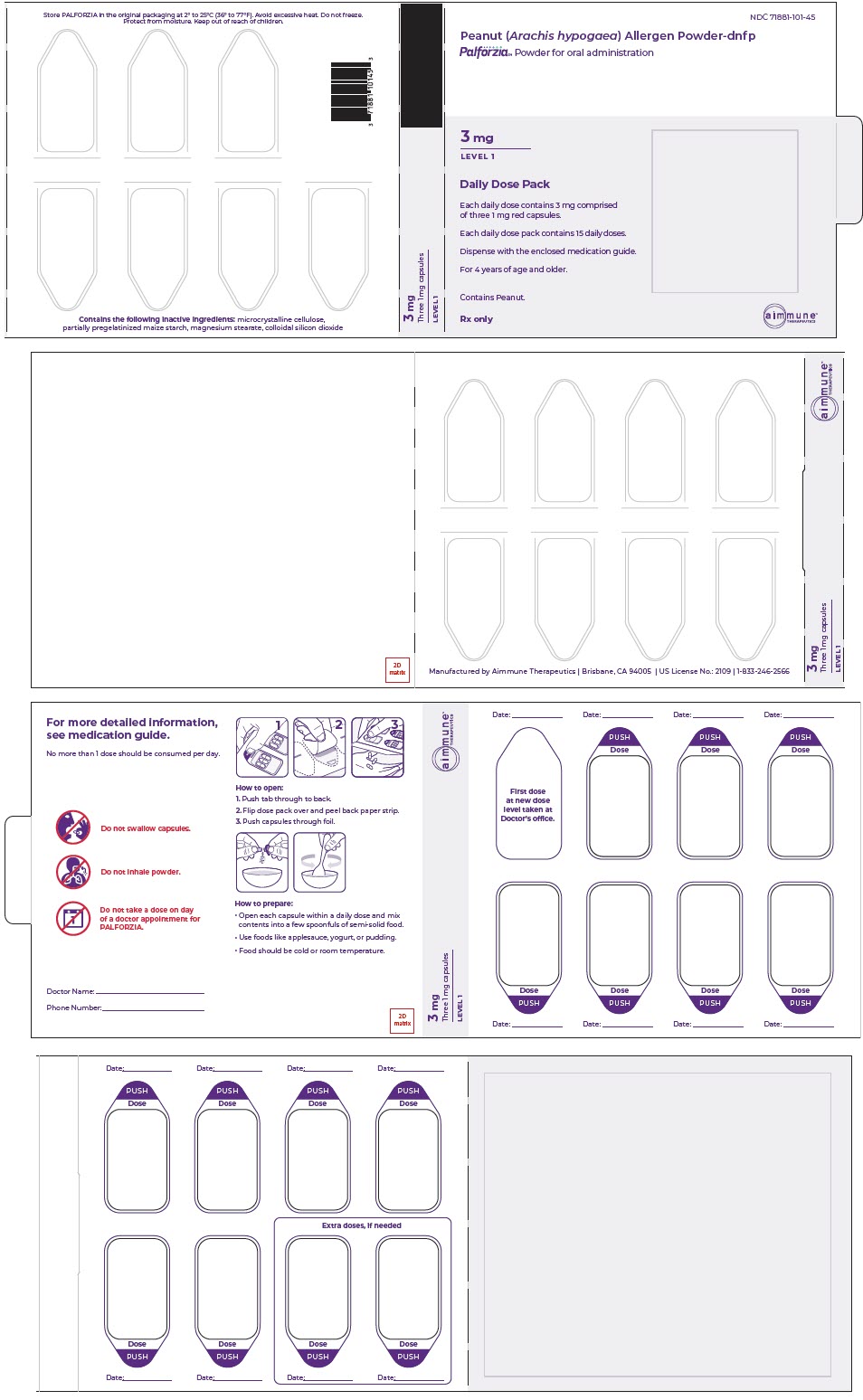
-
PRINCIPAL DISPLAY PANEL - Six 1 mg Capsule Dose Pack
NDC 71881-102-90
Peanut (Arachis hypogaea) Allergen Powder-dnfp
Palforzia ™ Powder for oral administration6 mg
LEVEL 2
Daily Dose Pack
Each daily dose contains 6 mg comprised
of six 1 mg red capsules.Each daily dose pack contains 15 daily doses.
Dispense with the enclosed medication guide.
For 4 years of age and older.
Contains Peanut.
Rx only
aimmune™
THERAPEUTICS
-
PRINCIPAL DISPLAY PANEL - Kit Dose Pack - 12 mg
NDC 71881-103-45
Peanut (Arachis hypogaea) Allergen Powder-dnfp
Palforzia ™ Powder for oral administration12 mg
LEVEL 3
Daily Dose Pack
Each daily dose contains 12 mg comprised
of two 1 mg red capsules and one 10 mg
blue capsule.Each daily dose pack contains 15 daily doses.
Dispense with the enclosed medication guide.
For 4 years of age and older.
Contains Peanut.
Rx only
aimmune™
THERAPEUTICS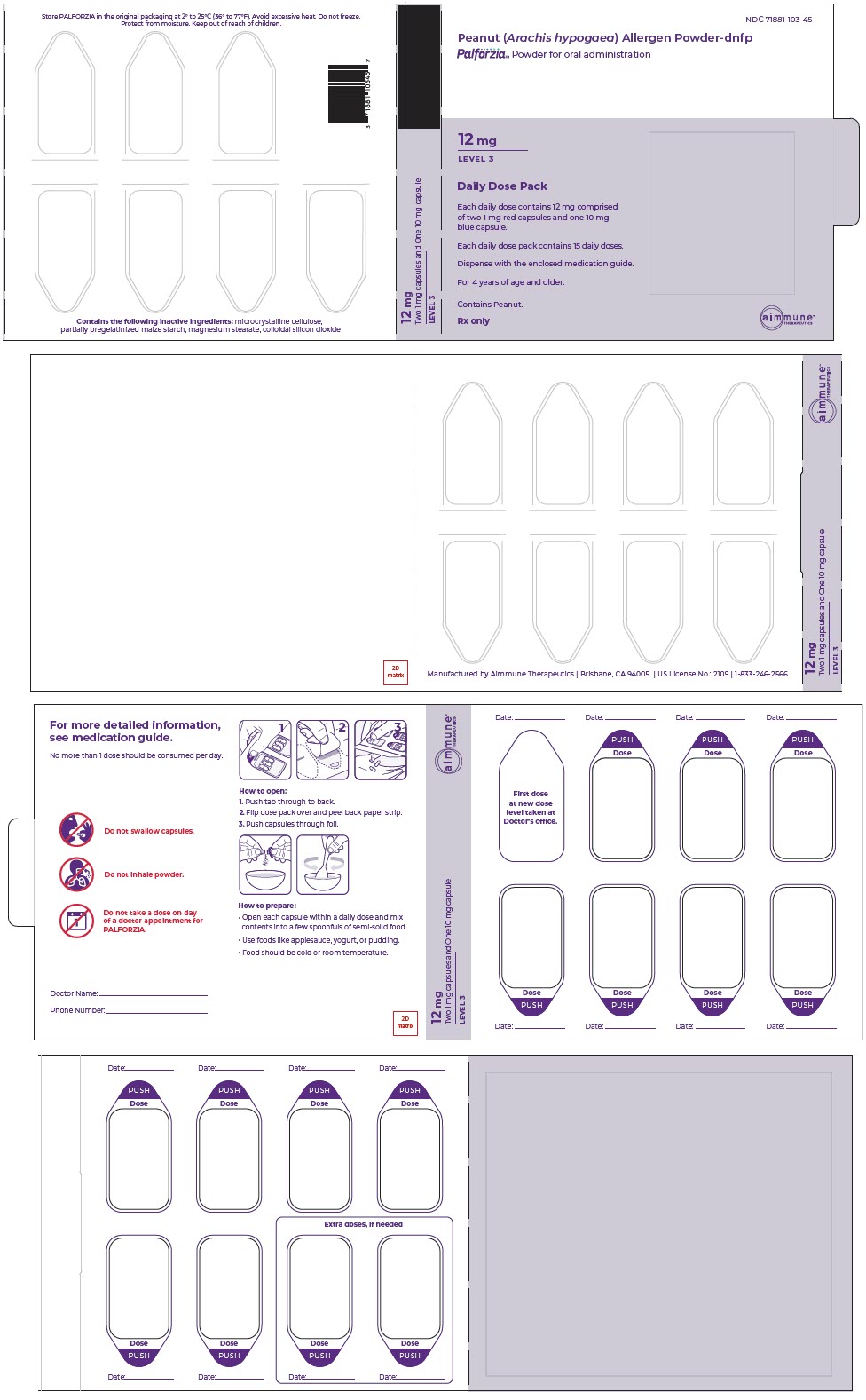
-
PRINCIPAL DISPLAY PANEL - One 20 mg Capsule Dose Pack
NDC 71881-104-15
Peanut (Arachis hypogaea) Allergen Powder-dnfp
Palforzia ™ Powder for oral administration20 mg
LEVEL 4
Daily Dose Pack
Each daily dose contains 20 mg comprised
of one 20 mg white capsule.Each daily dose pack contains 15 daily doses.
Dispense with the enclosed medication guide.
For 4 years of age and older.
Contains Peanut.
Rx only
aimmune™
THERAPEUTICS
-
PRINCIPAL DISPLAY PANEL - Two 20 mg Capsule Dose Pack
NDC 71881-105-30
Peanut (Arachis hypogaea) Allergen Powder-dnfp
Palforzia ™ Powder for oral administration40 mg
LEVEL 5
Daily Dose Pack
Each daily dose contains 40 mg comprised
of two 20 mg white capsules.Each daily dose pack contains 15 daily doses.
Dispense with the enclosed medication guide.
For 4 years of age and older.
Contains Peanut.
Rx only
aimmune™
THERAPEUTICS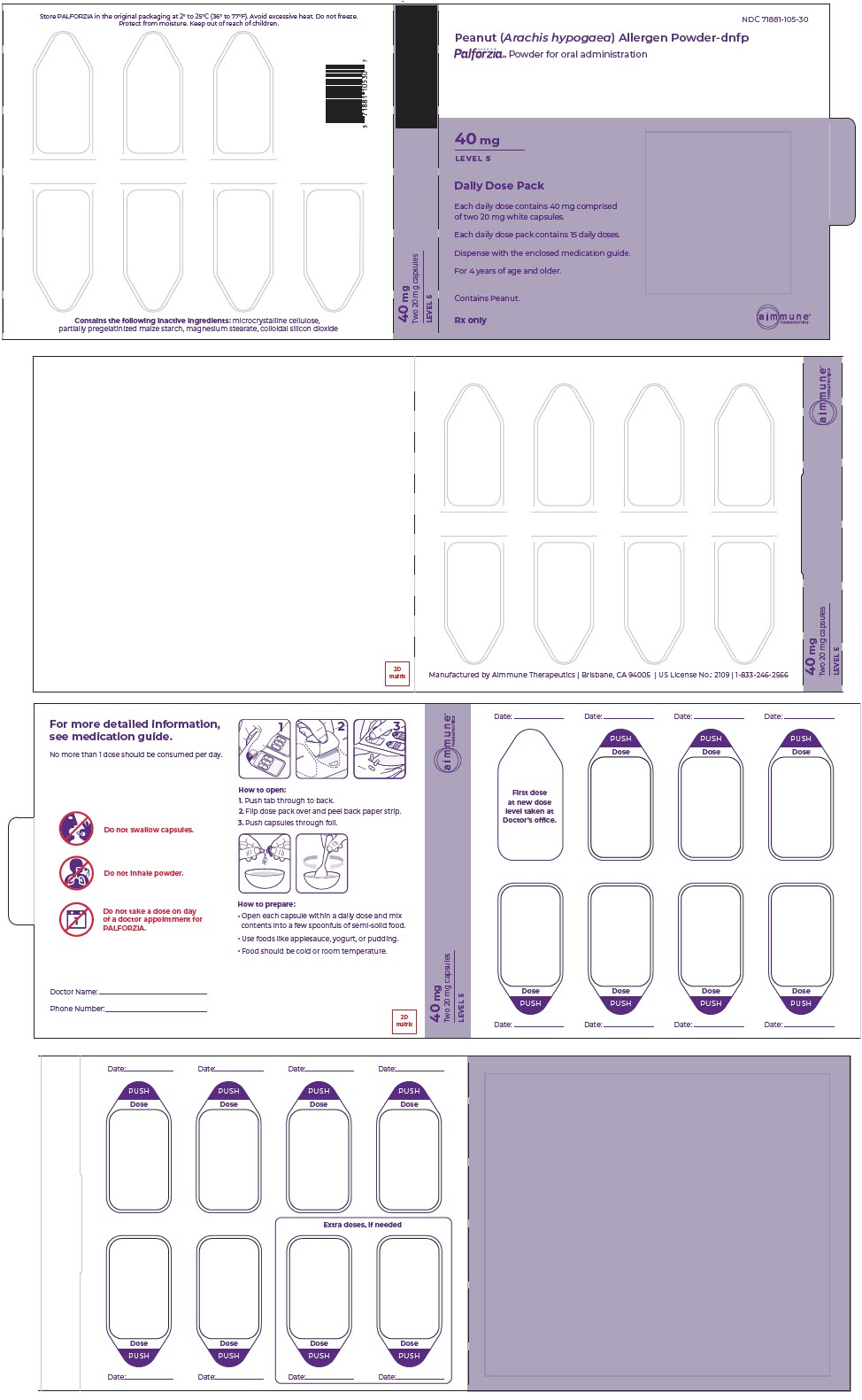
-
PRINCIPAL DISPLAY PANEL - Four 20 mg Capsule Dose Pack
NDC 71881-106-60
Peanut (Arachis hypogaea) Allergen Powder-dnfp
Palforzia ™ Powder for oral administration80 mg
LEVEL 6
Daily Dose Pack
Each daily dose contains 80 mg comprised
of four 20 mg white capsules.Each daily dose pack contains 15 daily doses.
Dispense with the enclosed medication guide.
For 4 years of age and older.
Contains Peanut.
Rx only
aimmune™
THERAPEUTICS
-
PRINCIPAL DISPLAY PANEL - Kit Dose Pack - 120 mg
NDC 71881-107-30
Peanut (Arachis hypogaea) Allergen Powder-dnfp
Palforzia ™ Powder for oral administration120 mg
LEVEL 7
Daily Dose Pack
Each daily dose contains 120 mg comprised
of one 20 mg white capsule and one 100 mg
red capsule.Each daily dose pack contains 15 daily doses.
Dispense with the enclosed medication guide.
For 4 years of age and older.
Contains Peanut.
Rx only
aimmune™
THERAPEUTICS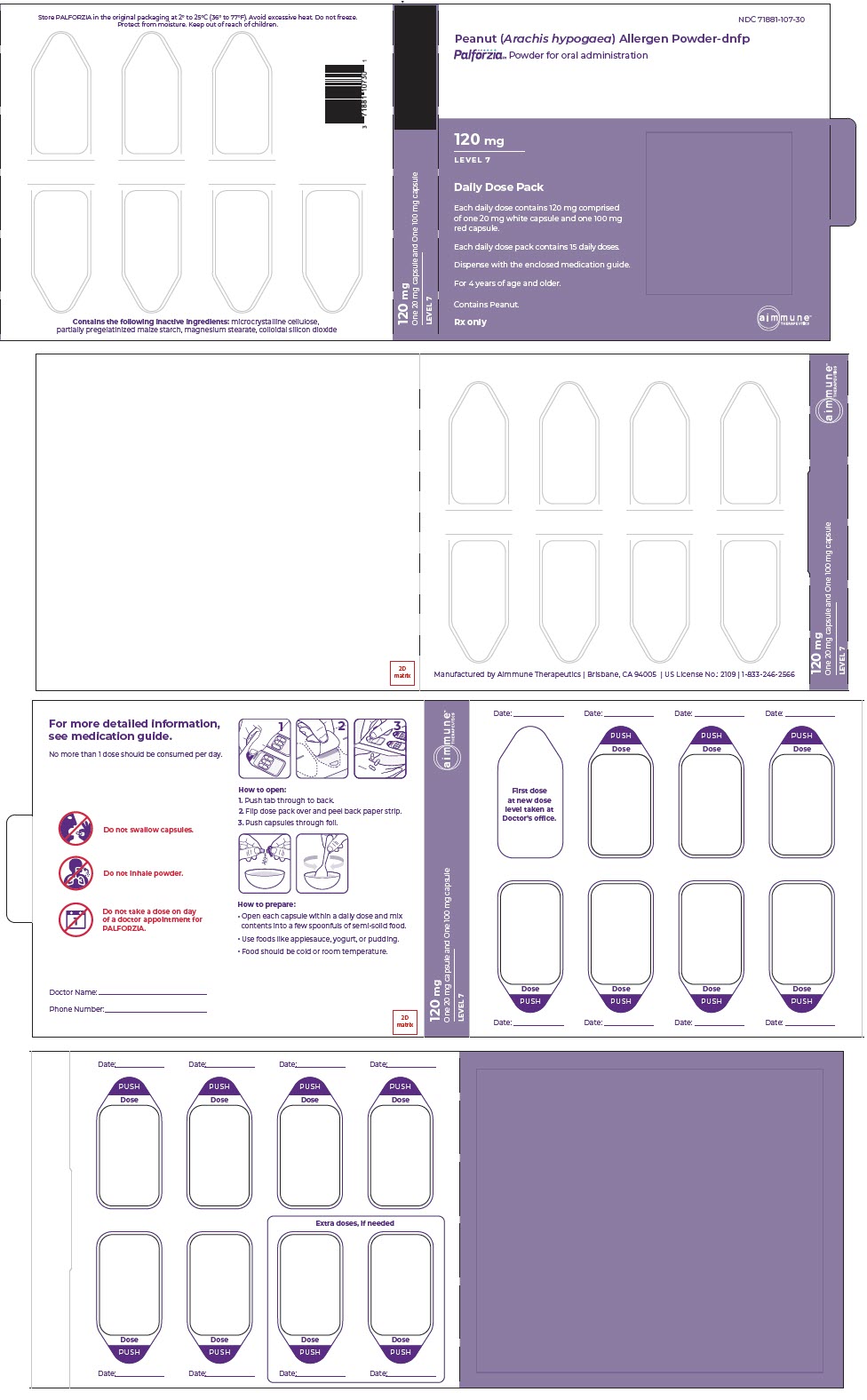
-
PRINCIPAL DISPLAY PANEL - Kit Dose Pack - 160 mg
NDC 71881-108-60
Peanut (Arachis hypogaea) Allergen Powder-dnfp
Palforzia ™ Powder for oral administration160 mg
LEVEL 8
Daily Dose Pack
Each daily dose contains 160 mg comprised
of three 20 mg white capsules and one 100 mg
red capsule.Each daily dose pack contains 15 daily doses.
Dispense with the enclosed medication guide.
For 4 years of age and older.
Contains Peanut.
Rx only
aimmune™
THERAPEUTICS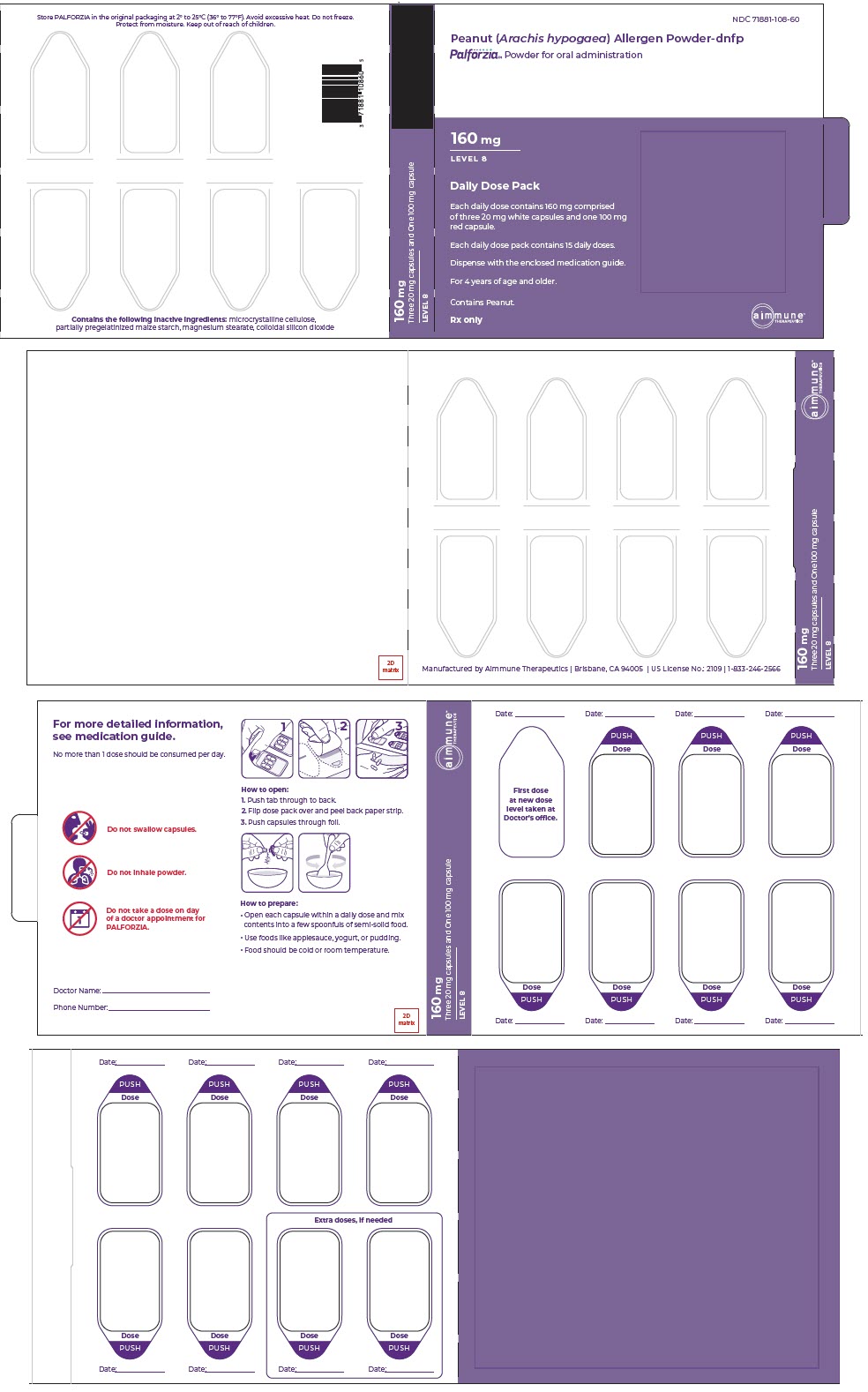
-
PRINCIPAL DISPLAY PANEL - Two 100 mg Capsule Dose Pack
NDC 71881-109-30
Peanut (Arachis hypogaea) Allergen Powder-dnfp
Palforzia ™ Powder for oral administration200 mg
LEVEL 9
Daily Dose Pack
Each daily dose contains 200 mg comprised
of two 100 mg red capsules.Each daily dose pack contains 15 daily doses.
Dispense with the enclosed medication guide.
For 4 years of age and older.
Contains Peanut.
Rx only
aimmune™
THERAPEUTICS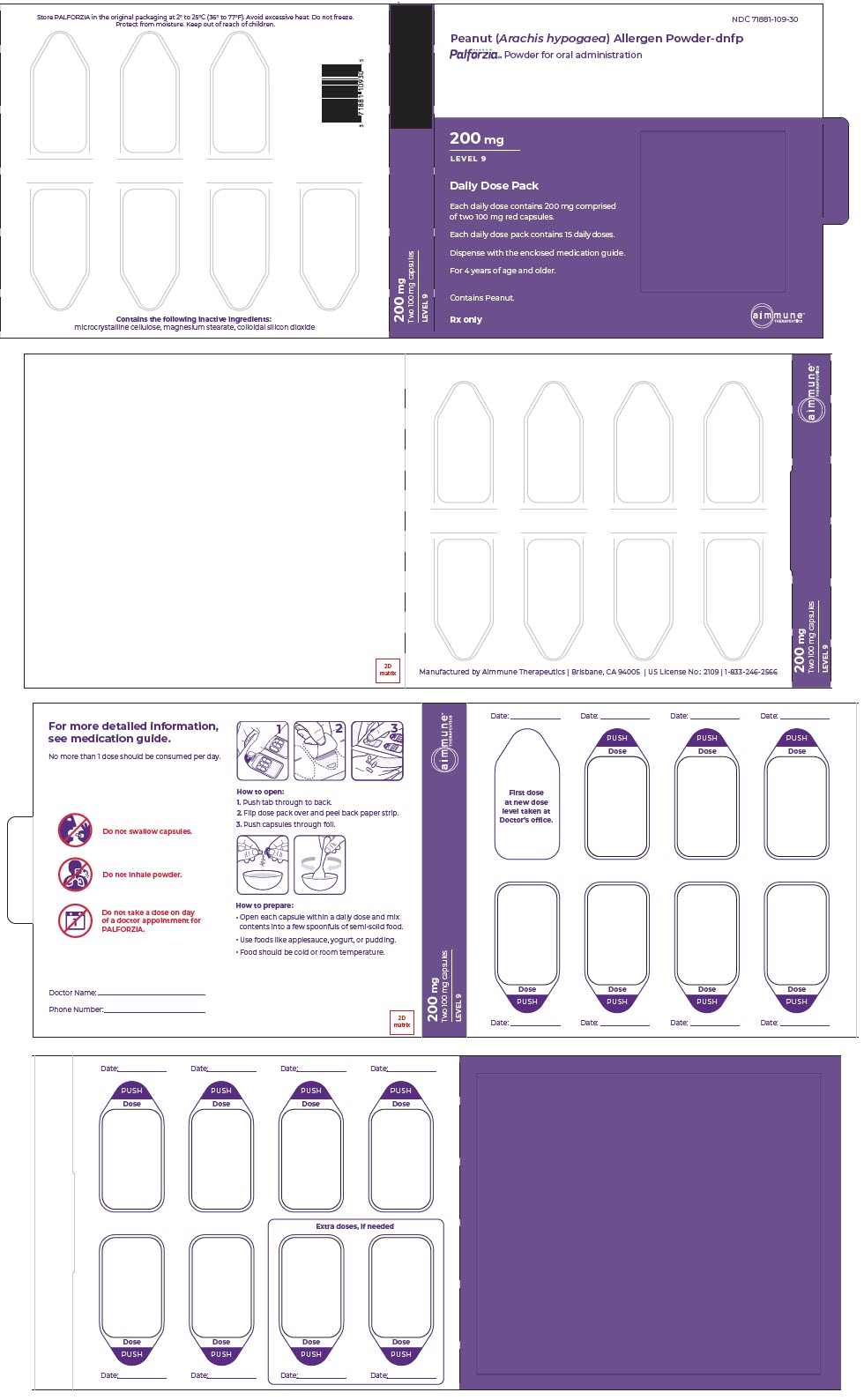
-
PRINCIPAL DISPLAY PANEL - Kit Dose Pack - 240 mg
NDC 71881-110-60
Peanut (Arachis hypogaea) Allergen Powder-dnfp
Palforzia ™ Powder for oral administration240 mg
LEVEL 10
Daily Dose Pack
Each daily dose contains 240 mg comprised
of two 20 mg white capsules and two 100 mg
red capsules.Each daily dose pack contains 15 daily doses.
Dispense with the enclosed medication guide.
For 4 years of age and older.
Contains Peanut.
Rx only
aimmune™
THERAPEUTICS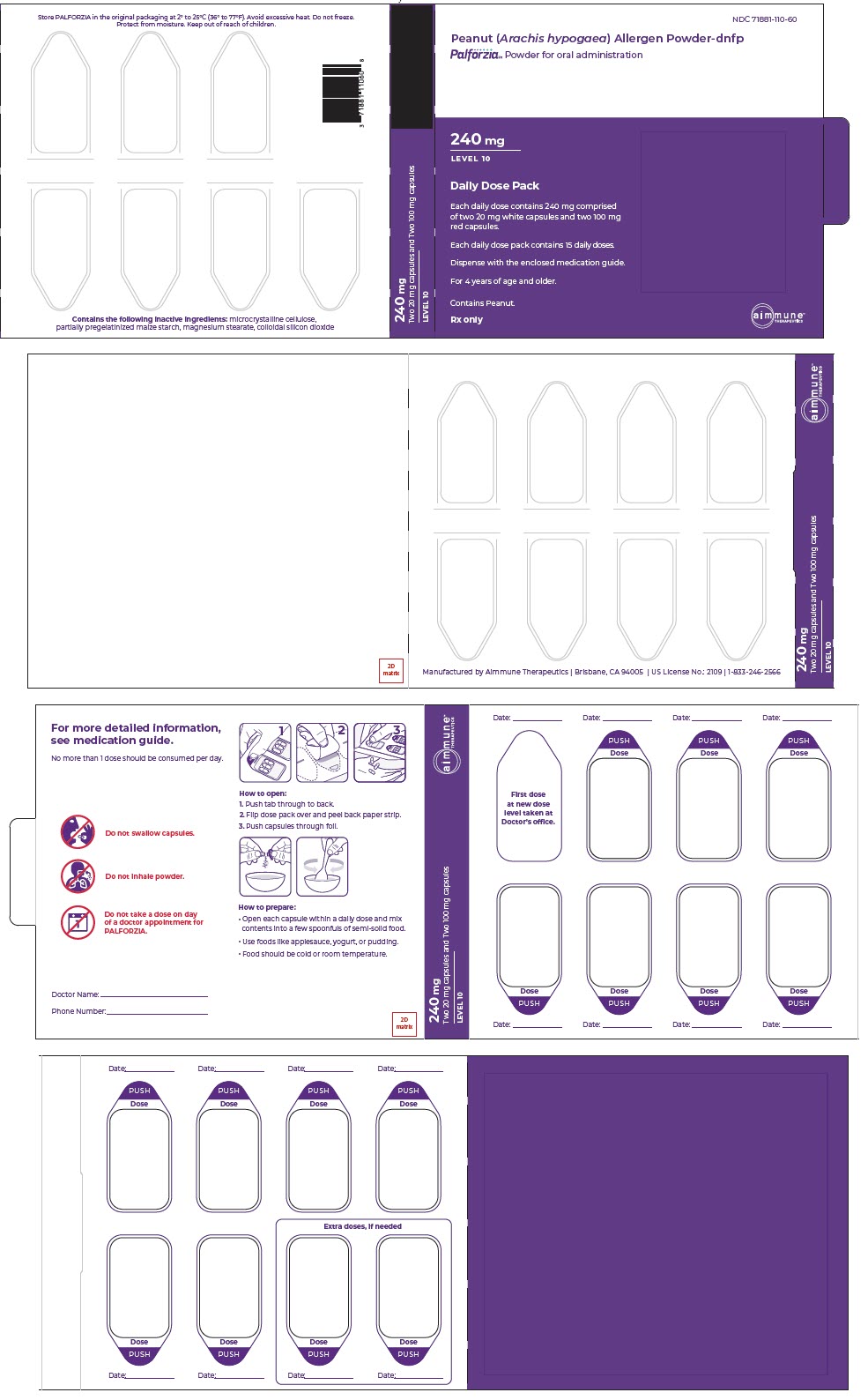
- PRINCIPAL DISPLAY PANEL - 300 mg Sachet Carton
-
INGREDIENTS AND APPEARANCE
PALFORZIA INITIAL DOSE ESCALATION
peanut kitProduct Information Product Type HUMAN PRESCRIPTION DRUG Item Code (Source) NDC:71881-113 Packaging # Item Code Package Description Marketing Start Date Marketing End Date 1 NDC:71881-113-13 1 in 1 BLISTER PACK 01/31/2020 Quantity of Parts Part # Package Quantity Total Product Quantity Part 1 2 CAPSULE 2 Part 2 11 CAPSULE 11 Part 1 of 2 PALFORZIA
peanut powderProduct Information Item Code (Source) NDC:71881-121 Route of Administration ORAL Active Ingredient/Active Moiety Ingredient Name Basis of Strength Strength PEANUT (UNII: QE1QX6B99R) (PEANUT - UNII:QE1QX6B99R) PEANUT 0.5 mg Packaging # Item Code Package Description Marketing Start Date Marketing End Date 1 NDC:71881-121-01 1 in 1 CAPSULE; Type 0: Not a Combination Product Marketing Information Marketing Category Application Number or Monograph Citation Marketing Start Date Marketing End Date BLA BLA125696 01/31/2020 Part 2 of 2 PALFORZIA
peanut powderProduct Information Item Code (Source) NDC:71881-122 Route of Administration ORAL Active Ingredient/Active Moiety Ingredient Name Basis of Strength Strength PEANUT (UNII: QE1QX6B99R) (PEANUT - UNII:QE1QX6B99R) PEANUT 1 mg Packaging # Item Code Package Description Marketing Start Date Marketing End Date 1 NDC:71881-122-01 1 in 1 CAPSULE; Type 0: Not a Combination Product Marketing Information Marketing Category Application Number or Monograph Citation Marketing Start Date Marketing End Date BLA BLA125696 01/31/2020 Marketing Information Marketing Category Application Number or Monograph Citation Marketing Start Date Marketing End Date BLA BLA125696 01/31/2020 PALFORZIA (LEVEL 1)
peanut powderProduct Information Product Type HUMAN PRESCRIPTION DRUG Item Code (Source) NDC:71881-101 Route of Administration ORAL Active Ingredient/Active Moiety Ingredient Name Basis of Strength Strength PEANUT (UNII: QE1QX6B99R) (PEANUT - UNII:QE1QX6B99R) PEANUT 3 mg Packaging # Item Code Package Description Marketing Start Date Marketing End Date 1 NDC:71881-101-45 45 in 1 BLISTER PACK 01/31/2020 1 1 in 1 CAPSULE; Type 0: Not a Combination Product 2 NDC:71881-101-99 18 in 1 CARTON 01/31/2020 2 NDC:71881-101-09 3 in 1 BLISTER PACK 2 1 in 1 CAPSULE; Type 0: Not a Combination Product Marketing Information Marketing Category Application Number or Monograph Citation Marketing Start Date Marketing End Date BLA BLA125696 01/31/2020 PALFORZIA (LEVEL 2)
peanut powderProduct Information Product Type HUMAN PRESCRIPTION DRUG Item Code (Source) NDC:71881-102 Route of Administration ORAL Active Ingredient/Active Moiety Ingredient Name Basis of Strength Strength PEANUT (UNII: QE1QX6B99R) (PEANUT - UNII:QE1QX6B99R) PEANUT 6 mg Packaging # Item Code Package Description Marketing Start Date Marketing End Date 1 NDC:71881-102-90 90 in 1 BLISTER PACK 01/31/2020 1 1 in 1 CAPSULE; Type 0: Not a Combination Product 2 NDC:71881-102-99 18 in 1 CARTON 01/31/2020 2 NDC:71881-102-09 6 in 1 BLISTER PACK 2 1 in 1 CAPSULE; Type 0: Not a Combination Product Marketing Information Marketing Category Application Number or Monograph Citation Marketing Start Date Marketing End Date BLA BLA125696 01/31/2020 PALFORZIA (LEVEL 3)
peanut kitProduct Information Product Type HUMAN PRESCRIPTION DRUG Item Code (Source) NDC:71881-103 Packaging # Item Code Package Description Marketing Start Date Marketing End Date 1 NDC:71881-103-45 15 in 1 PACKAGE 01/31/2020 1 1 in 1 BLISTER PACK 2 NDC:71881-103-99 12 in 1 CARTON 01/31/2020 2 NDC:71881-103-09 1 in 1 BLISTER PACK Quantity of Parts Part # Package Quantity Total Product Quantity Part 1 2 CAPSULE 2 Part 2 1 CAPSULE 1 Part 1 of 2 PALFORZIA
peanut powderProduct Information Item Code (Source) NDC:71881-122 Route of Administration ORAL Active Ingredient/Active Moiety Ingredient Name Basis of Strength Strength PEANUT (UNII: QE1QX6B99R) (PEANUT - UNII:QE1QX6B99R) PEANUT 1 mg Packaging # Item Code Package Description Marketing Start Date Marketing End Date 1 NDC:71881-122-01 1 in 1 CAPSULE; Type 0: Not a Combination Product Marketing Information Marketing Category Application Number or Monograph Citation Marketing Start Date Marketing End Date BLA BLA125696 01/31/2020 Part 2 of 2 PALFORZIA
peanut powderProduct Information Item Code (Source) NDC:71881-123 Route of Administration ORAL Active Ingredient/Active Moiety Ingredient Name Basis of Strength Strength PEANUT (UNII: QE1QX6B99R) (PEANUT - UNII:QE1QX6B99R) PEANUT 10 mg Packaging # Item Code Package Description Marketing Start Date Marketing End Date 1 NDC:71881-123-01 1 in 1 CAPSULE; Type 0: Not a Combination Product Marketing Information Marketing Category Application Number or Monograph Citation Marketing Start Date Marketing End Date BLA BLA125696 01/31/2020 Marketing Information Marketing Category Application Number or Monograph Citation Marketing Start Date Marketing End Date BLA BLA125696 01/31/2020 PALFORZIA (LEVEL 4)
peanut powderProduct Information Product Type HUMAN PRESCRIPTION DRUG Item Code (Source) NDC:71881-104 Route of Administration ORAL Active Ingredient/Active Moiety Ingredient Name Basis of Strength Strength PEANUT (UNII: QE1QX6B99R) (PEANUT - UNII:QE1QX6B99R) PEANUT 20 mg Packaging # Item Code Package Description Marketing Start Date Marketing End Date 1 NDC:71881-104-15 15 in 1 BLISTER PACK 01/31/2020 1 1 in 1 CAPSULE; Type 0: Not a Combination Product 2 NDC:71881-104-99 12 in 1 CARTON 01/31/2020 2 NDC:71881-104-09 1 in 1 BLISTER PACK 2 1 in 1 CAPSULE; Type 0: Not a Combination Product Marketing Information Marketing Category Application Number or Monograph Citation Marketing Start Date Marketing End Date BLA BLA125696 01/31/2020 PALFORZIA (LEVEL 5)
peanut powderProduct Information Product Type HUMAN PRESCRIPTION DRUG Item Code (Source) NDC:71881-105 Route of Administration ORAL Active Ingredient/Active Moiety Ingredient Name Basis of Strength Strength PEANUT (UNII: QE1QX6B99R) (PEANUT - UNII:QE1QX6B99R) PEANUT 40 mg Packaging # Item Code Package Description Marketing Start Date Marketing End Date 1 NDC:71881-105-30 30 in 1 BLISTER PACK 01/31/2020 1 1 in 1 CAPSULE; Type 0: Not a Combination Product 2 NDC:71881-105-99 12 in 1 CARTON 01/31/2020 2 NDC:71881-105-09 2 in 1 BLISTER PACK 2 1 in 1 CAPSULE; Type 0: Not a Combination Product Marketing Information Marketing Category Application Number or Monograph Citation Marketing Start Date Marketing End Date BLA BLA125696 01/31/2020 PALFORZIA (LEVEL 6)
peanut powderProduct Information Product Type HUMAN PRESCRIPTION DRUG Item Code (Source) NDC:71881-106 Route of Administration ORAL Active Ingredient/Active Moiety Ingredient Name Basis of Strength Strength PEANUT (UNII: QE1QX6B99R) (PEANUT - UNII:QE1QX6B99R) PEANUT 80 mg Packaging # Item Code Package Description Marketing Start Date Marketing End Date 1 NDC:71881-106-60 60 in 1 BLISTER PACK 01/31/2020 1 1 in 1 CAPSULE; Type 0: Not a Combination Product 2 NDC:71881-106-99 12 in 1 CARTON 01/31/2020 2 NDC:71881-106-09 4 in 1 BLISTER PACK 2 1 in 1 CAPSULE; Type 0: Not a Combination Product Marketing Information Marketing Category Application Number or Monograph Citation Marketing Start Date Marketing End Date BLA BLA125696 01/31/2020 PALFORZIA (LEVEL 7)
peanut kitProduct Information Product Type HUMAN PRESCRIPTION DRUG Item Code (Source) NDC:71881-107 Packaging # Item Code Package Description Marketing Start Date Marketing End Date 1 NDC:71881-107-30 15 in 1 PACKAGE 01/31/2020 1 1 in 1 BLISTER PACK 2 NDC:71881-107-99 12 in 1 CARTON 01/31/2020 2 NDC:71881-107-09 1 in 1 BLISTER PACK Quantity of Parts Part # Package Quantity Total Product Quantity Part 1 1 CAPSULE 1 Part 2 1 CAPSULE 1 Part 1 of 2 PALFORZIA
peanut powderProduct Information Item Code (Source) NDC:71881-124 Route of Administration ORAL Active Ingredient/Active Moiety Ingredient Name Basis of Strength Strength PEANUT (UNII: QE1QX6B99R) (PEANUT - UNII:QE1QX6B99R) PEANUT 20 mg Packaging # Item Code Package Description Marketing Start Date Marketing End Date 1 NDC:71881-124-01 1 in 1 CAPSULE; Type 0: Not a Combination Product Marketing Information Marketing Category Application Number or Monograph Citation Marketing Start Date Marketing End Date BLA BLA125696 01/31/2020 Part 2 of 2 PALFORZIA
peanut powderProduct Information Item Code (Source) NDC:71881-125 Route of Administration ORAL Active Ingredient/Active Moiety Ingredient Name Basis of Strength Strength PEANUT (UNII: QE1QX6B99R) (PEANUT - UNII:QE1QX6B99R) PEANUT 100 mg Packaging # Item Code Package Description Marketing Start Date Marketing End Date 1 NDC:71881-125-01 1 in 1 CAPSULE; Type 0: Not a Combination Product Marketing Information Marketing Category Application Number or Monograph Citation Marketing Start Date Marketing End Date BLA BLA125696 01/31/2020 Marketing Information Marketing Category Application Number or Monograph Citation Marketing Start Date Marketing End Date BLA BLA125696 01/31/2020 PALFORZIA (LEVEL 8)
peanut kitProduct Information Product Type HUMAN PRESCRIPTION DRUG Item Code (Source) NDC:71881-108 Packaging # Item Code Package Description Marketing Start Date Marketing End Date 1 NDC:71881-108-60 15 in 1 PACKAGE 01/31/2020 1 1 in 1 BLISTER PACK 2 NDC:71881-108-99 12 in 1 CARTON 01/31/2020 2 NDC:71881-108-09 1 in 1 BLISTER PACK Quantity of Parts Part # Package Quantity Total Product Quantity Part 1 3 CAPSULE 3 Part 2 1 CAPSULE 1 Part 1 of 2 PALFORZIA
peanut powderProduct Information Item Code (Source) NDC:71881-124 Route of Administration ORAL Active Ingredient/Active Moiety Ingredient Name Basis of Strength Strength PEANUT (UNII: QE1QX6B99R) (PEANUT - UNII:QE1QX6B99R) PEANUT 20 mg Packaging # Item Code Package Description Marketing Start Date Marketing End Date 1 NDC:71881-124-01 1 in 1 CAPSULE; Type 0: Not a Combination Product Marketing Information Marketing Category Application Number or Monograph Citation Marketing Start Date Marketing End Date BLA BLA125696 01/31/2020 Part 2 of 2 PALFORZIA
peanut powderProduct Information Item Code (Source) NDC:71881-125 Route of Administration ORAL Active Ingredient/Active Moiety Ingredient Name Basis of Strength Strength PEANUT (UNII: QE1QX6B99R) (PEANUT - UNII:QE1QX6B99R) PEANUT 100 mg Packaging # Item Code Package Description Marketing Start Date Marketing End Date 1 NDC:71881-125-01 1 in 1 CAPSULE; Type 0: Not a Combination Product Marketing Information Marketing Category Application Number or Monograph Citation Marketing Start Date Marketing End Date BLA BLA125696 01/31/2020 Marketing Information Marketing Category Application Number or Monograph Citation Marketing Start Date Marketing End Date BLA BLA125696 01/31/2020 PALFORZIA (LEVEL 9)
peanut powderProduct Information Product Type HUMAN PRESCRIPTION DRUG Item Code (Source) NDC:71881-109 Route of Administration ORAL Active Ingredient/Active Moiety Ingredient Name Basis of Strength Strength PEANUT (UNII: QE1QX6B99R) (PEANUT - UNII:QE1QX6B99R) PEANUT 200 mg Packaging # Item Code Package Description Marketing Start Date Marketing End Date 1 NDC:71881-109-30 30 in 1 BLISTER PACK 01/31/2020 1 1 in 1 CAPSULE; Type 0: Not a Combination Product 2 NDC:71881-109-99 12 in 1 CARTON 01/31/2020 2 NDC:71881-109-09 2 in 1 BLISTER PACK 2 1 in 1 CAPSULE; Type 0: Not a Combination Product Marketing Information Marketing Category Application Number or Monograph Citation Marketing Start Date Marketing End Date BLA BLA125696 01/31/2020 PALFORZIA (LEVEL 10)
peanut kitProduct Information Product Type HUMAN PRESCRIPTION DRUG Item Code (Source) NDC:71881-110 Packaging # Item Code Package Description Marketing Start Date Marketing End Date 1 NDC:71881-110-60 15 in 1 PACKAGE 01/31/2020 1 1 in 1 BLISTER PACK 2 NDC:71881-110-99 12 in 1 CARTON 01/31/2020 2 NDC:71881-110-09 1 in 1 BLISTER PACK Quantity of Parts Part # Package Quantity Total Product Quantity Part 1 2 CAPSULE 2 Part 2 2 CAPSULE 2 Part 1 of 2 PALFORZIA
peanut powderProduct Information Item Code (Source) NDC:71881-124 Route of Administration ORAL Active Ingredient/Active Moiety Ingredient Name Basis of Strength Strength PEANUT (UNII: QE1QX6B99R) (PEANUT - UNII:QE1QX6B99R) PEANUT 20 mg Packaging # Item Code Package Description Marketing Start Date Marketing End Date 1 NDC:71881-124-01 1 in 1 CAPSULE; Type 0: Not a Combination Product Marketing Information Marketing Category Application Number or Monograph Citation Marketing Start Date Marketing End Date BLA BLA125696 01/31/2020 Part 2 of 2 PALFORZIA
peanut powderProduct Information Item Code (Source) NDC:71881-125 Route of Administration ORAL Active Ingredient/Active Moiety Ingredient Name Basis of Strength Strength PEANUT (UNII: QE1QX6B99R) (PEANUT - UNII:QE1QX6B99R) PEANUT 100 mg Packaging # Item Code Package Description Marketing Start Date Marketing End Date 1 NDC:71881-125-01 1 in 1 CAPSULE; Type 0: Not a Combination Product Marketing Information Marketing Category Application Number or Monograph Citation Marketing Start Date Marketing End Date BLA BLA125696 01/31/2020 Marketing Information Marketing Category Application Number or Monograph Citation Marketing Start Date Marketing End Date BLA BLA125696 01/31/2020 PALFORZIA (LEVEL 11)
peanut powderProduct Information Product Type HUMAN PRESCRIPTION DRUG Item Code (Source) NDC:71881-111 Route of Administration ORAL Active Ingredient/Active Moiety Ingredient Name Basis of Strength Strength PEANUT (UNII: QE1QX6B99R) (PEANUT - UNII:QE1QX6B99R) PEANUT 300 mg Packaging # Item Code Package Description Marketing Start Date Marketing End Date 1 NDC:71881-111-15 15 in 1 CARTON 01/31/2020 1 1 in 1 POUCH; Type 0: Not a Combination Product 2 NDC:71881-111-30 30 in 1 CARTON 01/31/2020 2 1 in 1 POUCH; Type 0: Not a Combination Product 3 NDC:71881-111-99 15 in 1 CARTON 01/31/2020 3 1 in 1 POUCH; Type 0: Not a Combination Product Marketing Information Marketing Category Application Number or Monograph Citation Marketing Start Date Marketing End Date BLA BLA125696 01/31/2020 Labeler - Aimmune Therapeutics (057562771)

